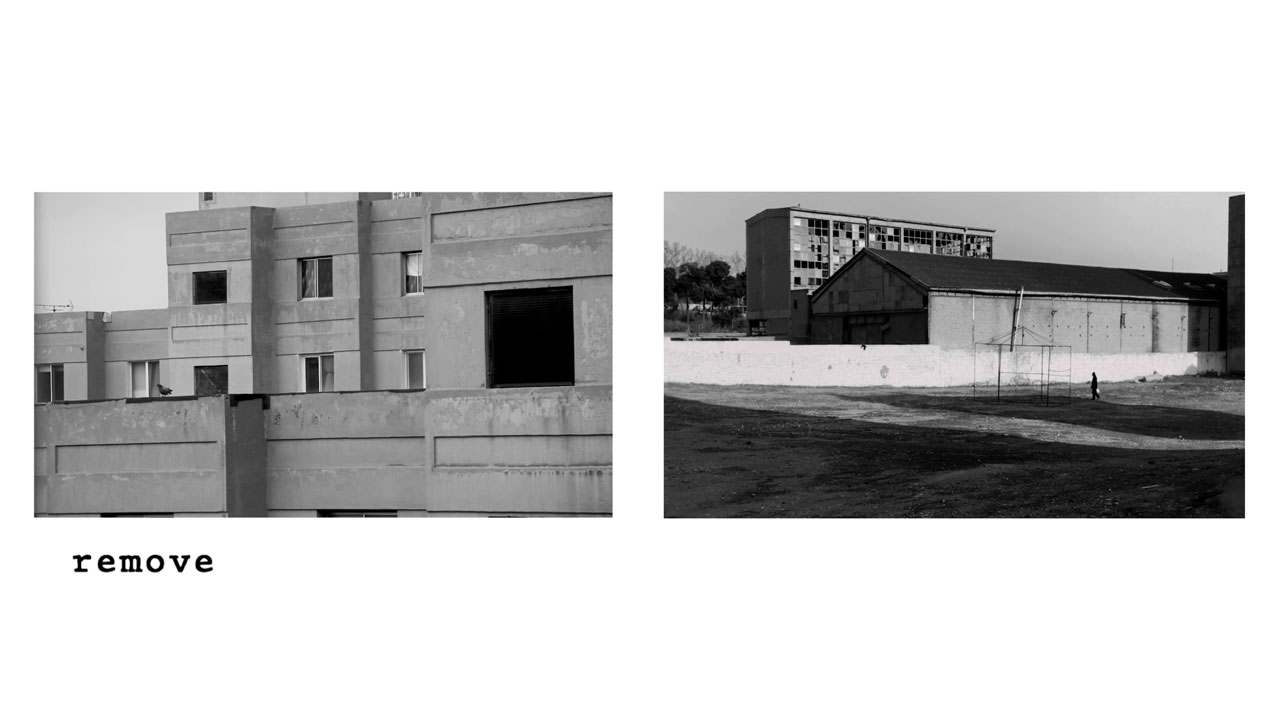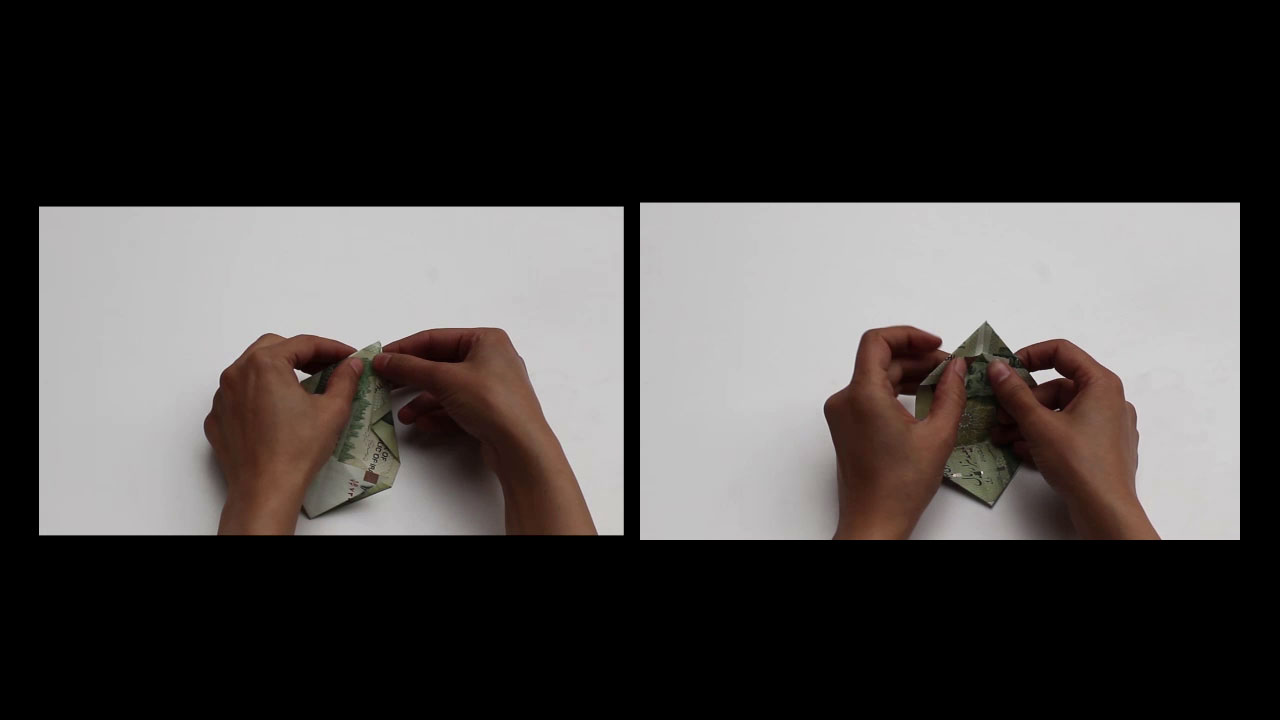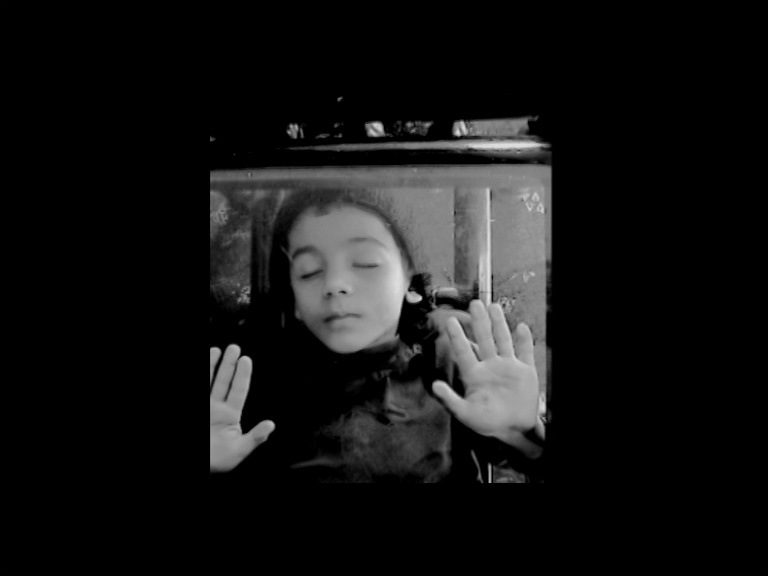As the festival’s tradition, the Forum section is one of the main pillars of the program and includes the entries which have been gathered from the submissions to the open call and a second look at the archive. They are arranged carefully to shed light on recent developments in the field of moving images while rediscovering some older pieces which are resurfaced via the process of “Media” archeology. The Limited Access Forum is not intended to present a thematic series of works, instead attempts to imagine a fragile path where we can observe vibrant levels of films, videos, and new media. Regarding the time-consuming process to select the works and put them together from the new makers in the scene to the established endeavors. The diversity of the media(s), used by the artists and the vast range of the tackled topics envisages an insight of the currents. In an era where the media sold us an illusion of being always connected and having constant access to all we assume we need, and being bombarded by the live feeds, “Limited Access Forum” tries to redraw experimental detours via the city, the surrounding environmental aftermaths, the narrative fragments of the society and the abstract readings of the present tense
Forum A
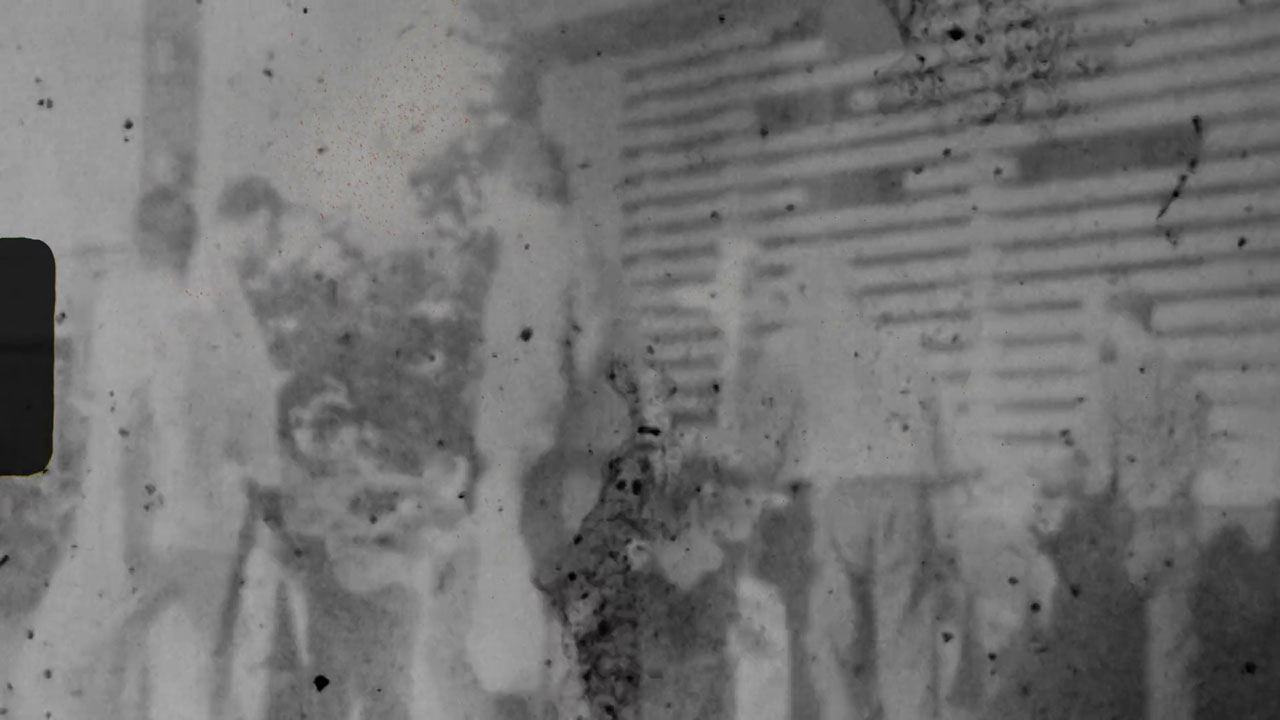 The poet, Ali Sarandibi takes us to an experimental journey into his workplace in The Grand Hall of Books in Enghelab Street in Tehran, best known for its bookshops and Tehran University. The narrative is from the shopkeepers telling the story of the passage and how their work conditions have changed lately.
The poet, Ali Sarandibi takes us to an experimental journey into his workplace in The Grand Hall of Books in Enghelab Street in Tehran, best known for its bookshops and Tehran University. The narrative is from the shopkeepers telling the story of the passage and how their work conditions have changed lately.
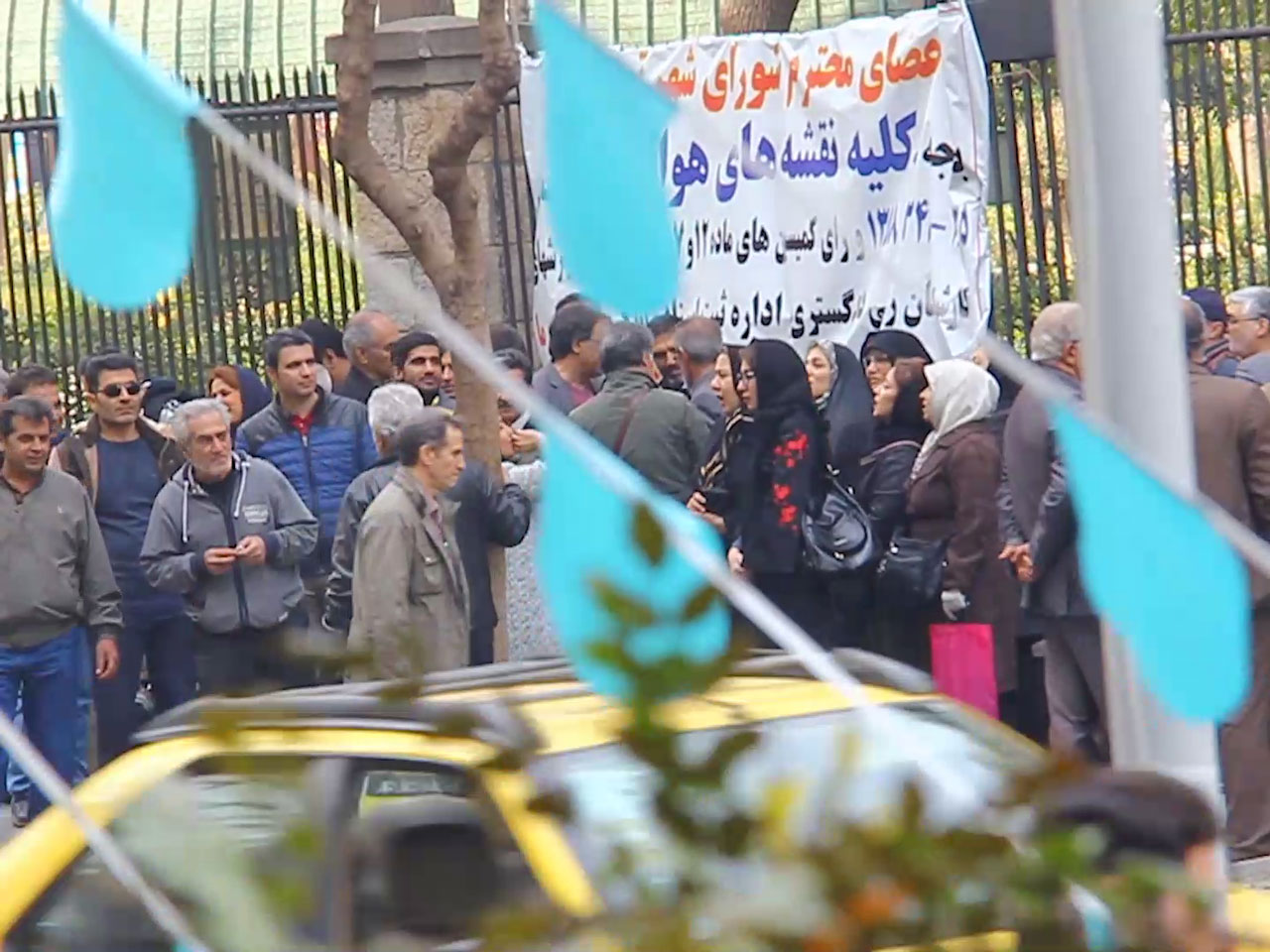 No description
No description
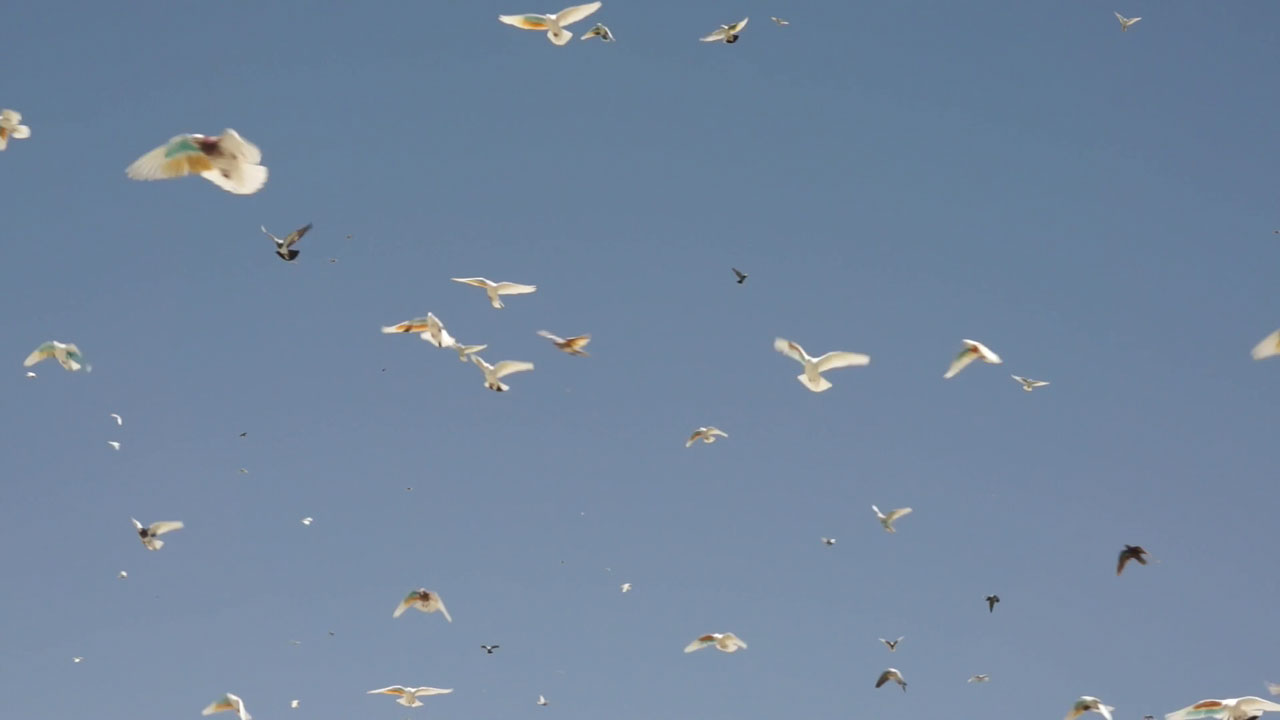 It’s not true that all pigeon keepers and fanciers will necessarily end up gambling. He can only be called a pigeon fancier and, in his own words, a lover, following his father way of life. He believes that it must be in your genes. Above all, this extent of longing and passion is not compatible with any kind of logic.
It’s not true that all pigeon keepers and fanciers will necessarily end up gambling. He can only be called a pigeon fancier and, in his own words, a lover, following his father way of life. He believes that it must be in your genes. Above all, this extent of longing and passion is not compatible with any kind of logic.
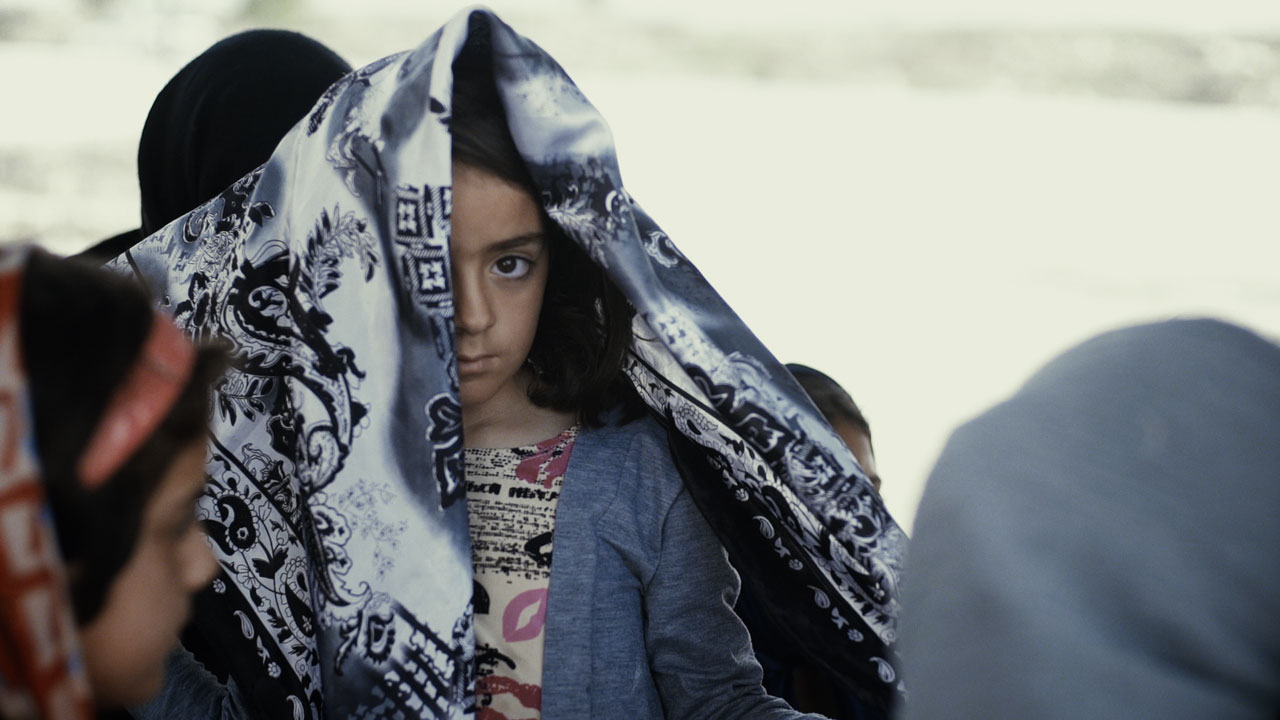 The Scent of Bread is a short documentary shot in Kuik-e Hasan village, Kermanshah, 160 days after the destruction of the entire village by the earthquake.
The Scent of Bread is a short documentary shot in Kuik-e Hasan village, Kermanshah, 160 days after the destruction of the entire village by the earthquake.
In praise or condemnation of the eternal search for a homeland
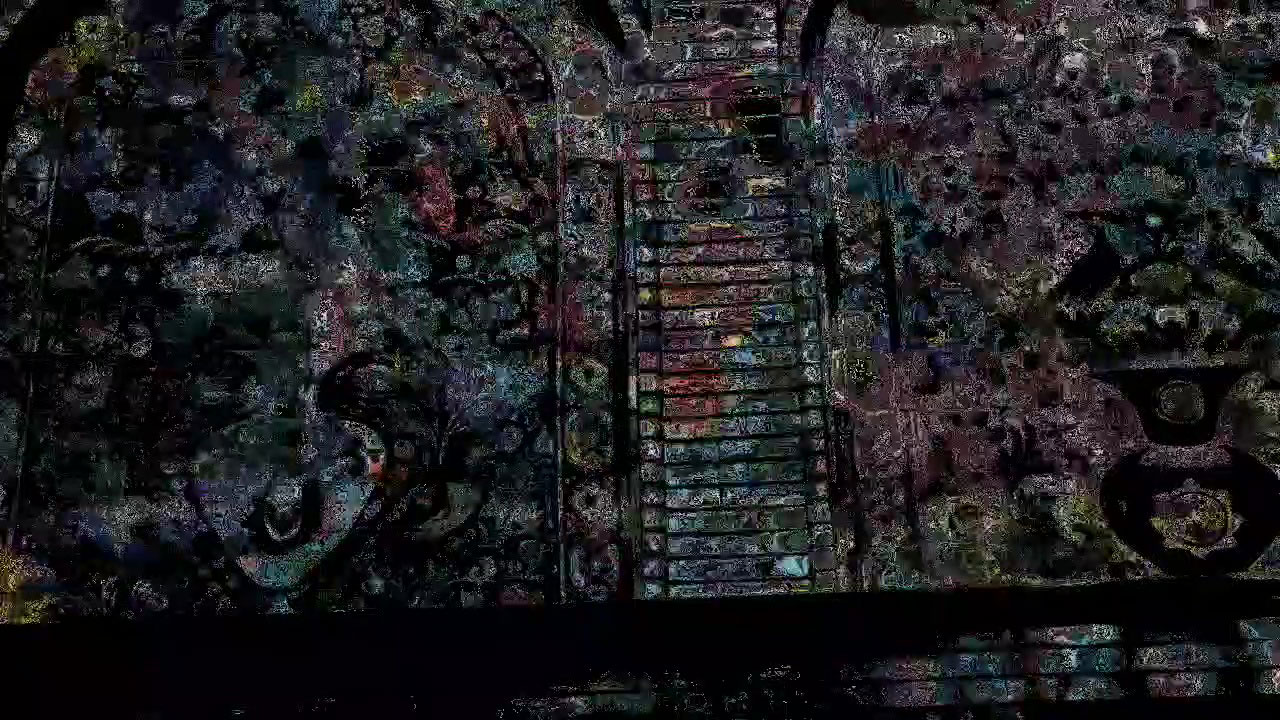 The palace of flowers has put Iran on Fire.
The palace of flowers has put Iran on Fire.
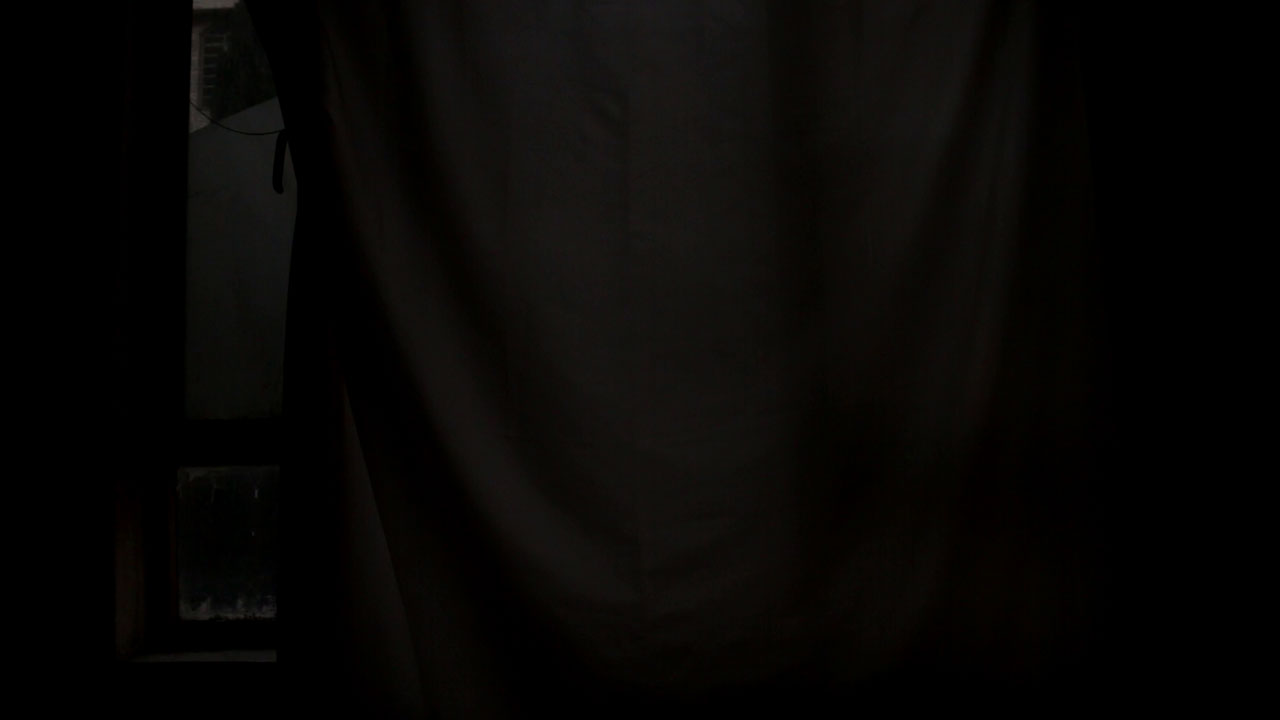 The daily life in the crowded city leaves us no chance to take a moment and think. There cannot be an escape even in your own room. Yet, staring at the window lets one to think of the time passing.
The daily life in the crowded city leaves us no chance to take a moment and think. There cannot be an escape even in your own room. Yet, staring at the window lets one to think of the time passing.
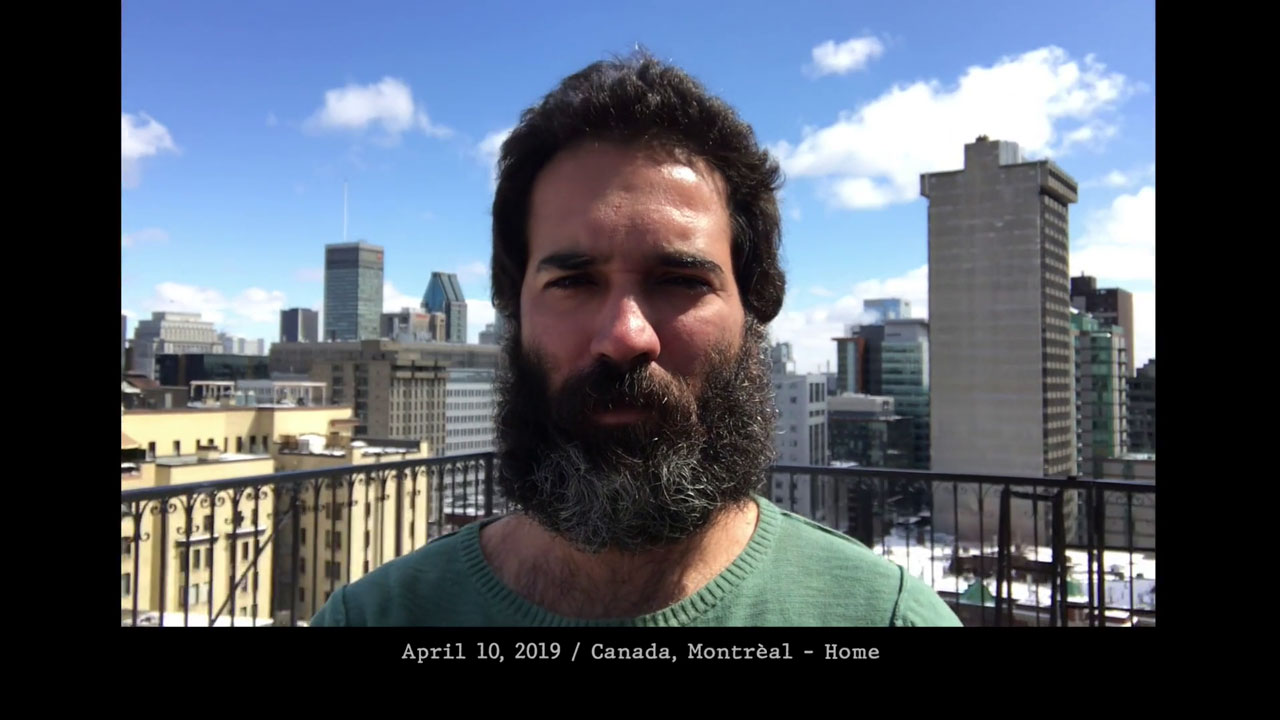 Don’t know where I belong. Though longing to move forward, my memories keep dragging me back. Far away from home, floating between the two worlds, Lost in a limbo.
Don’t know where I belong. Though longing to move forward, my memories keep dragging me back. Far away from home, floating between the two worlds, Lost in a limbo.
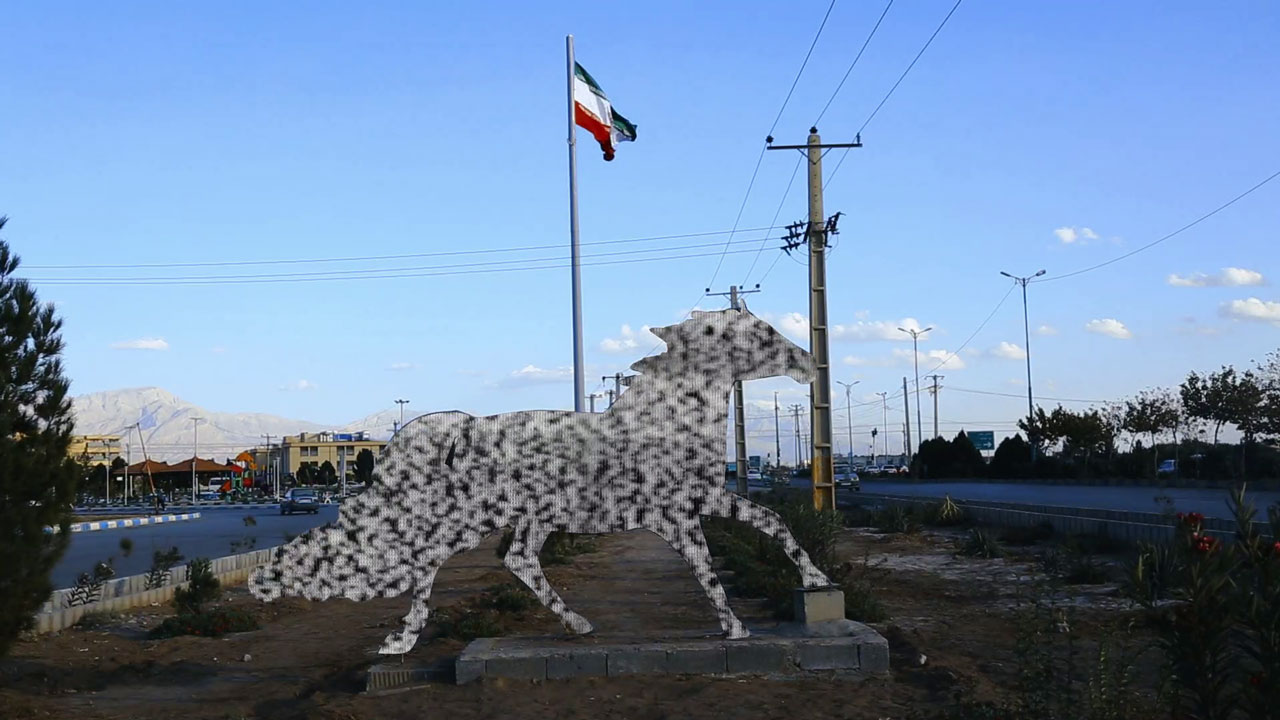 No description
No description
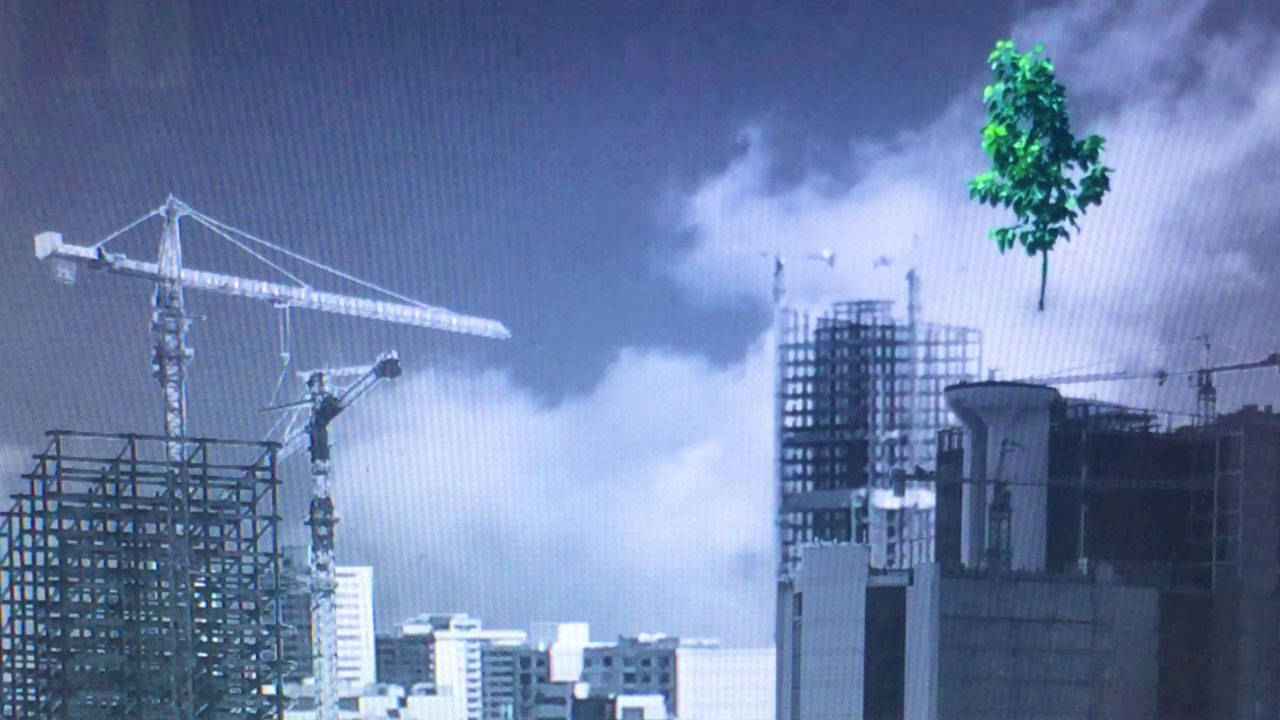 City noises Vol.2 is a video about unconstrained and non-principled constructions and destruction of nature in Tehran city. It shows the aspects, regarding visual and noise pollution during 24 hours. Meanwhile today citizens observe all of these cases as a matter of routine and are not sensitive about it anymore…
City noises Vol.2 is a video about unconstrained and non-principled constructions and destruction of nature in Tehran city. It shows the aspects, regarding visual and noise pollution during 24 hours. Meanwhile today citizens observe all of these cases as a matter of routine and are not sensitive about it anymore…
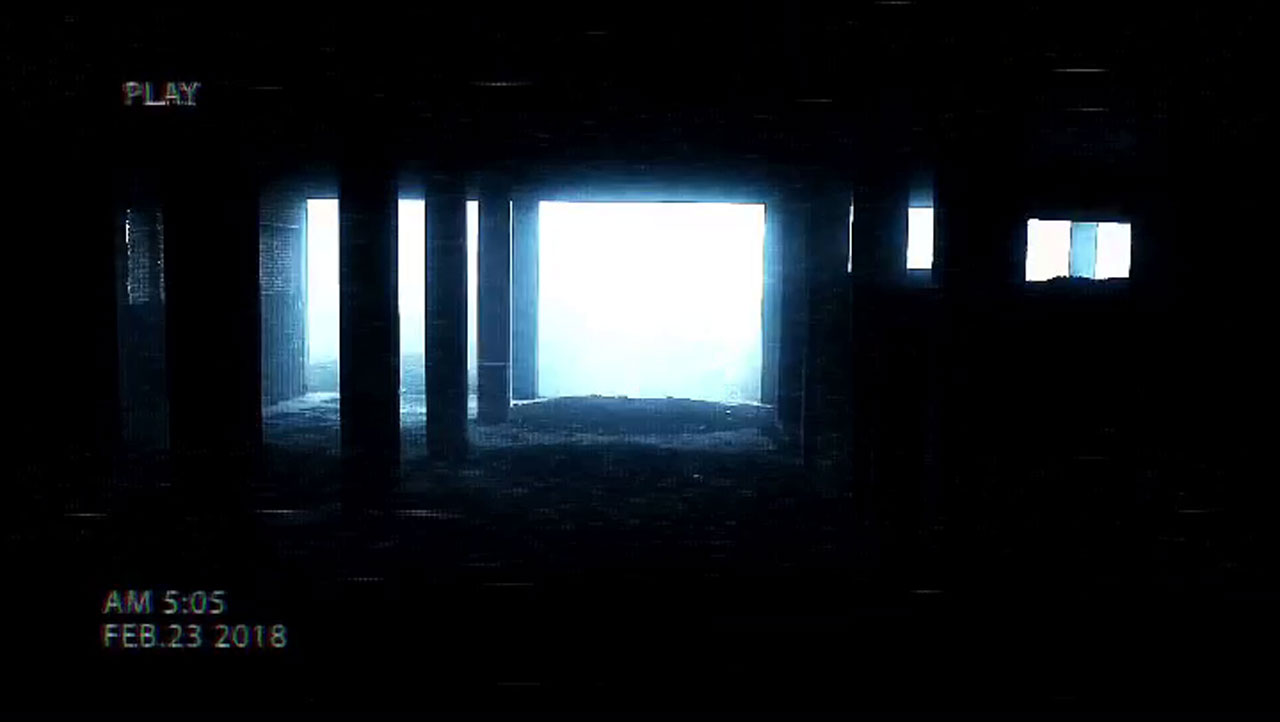 No description
No description
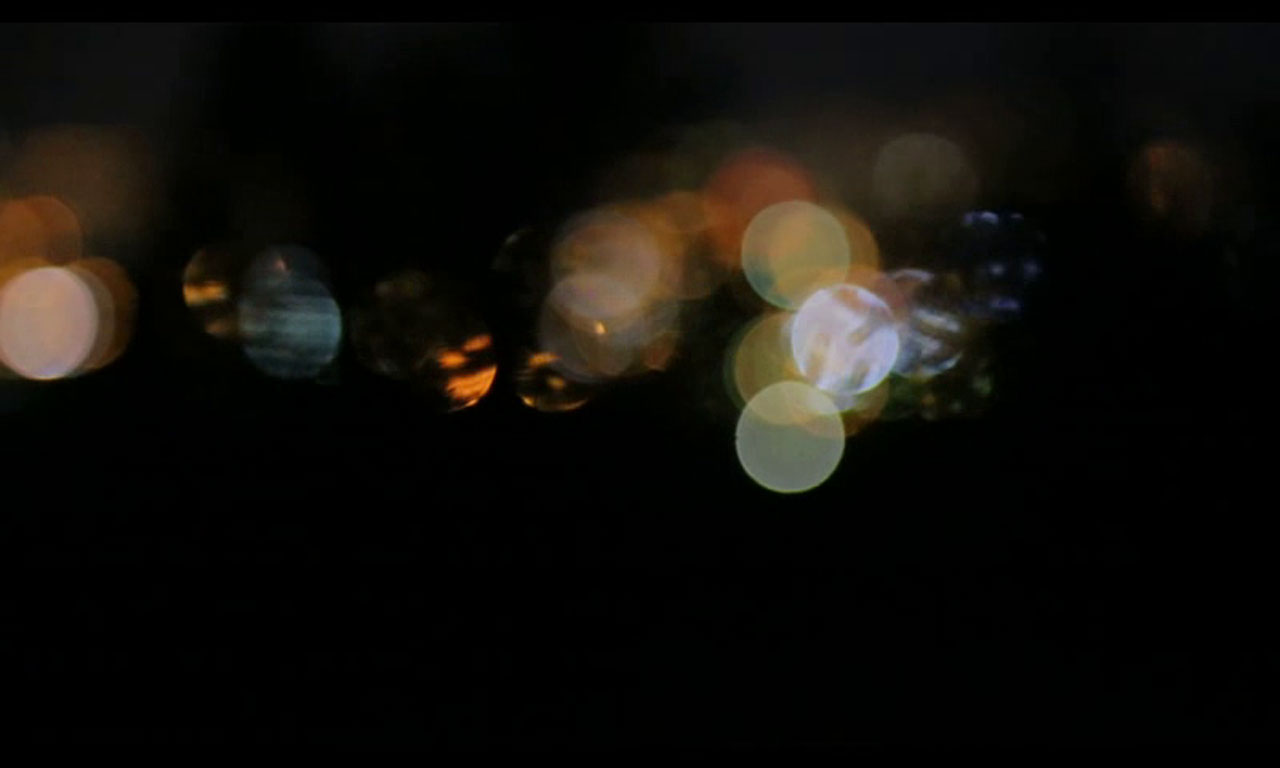 Nature is ever-changing and the visual compositions that have formed by it only stay still for few moments tracing aspect of instability and changing that made me turn all those “happened” to some things is “happening” by the camera. These are the multi-dimensional fact that different objects create different associations. Merging the multi meaning and undefinable of a same and destroyed target in a frame, in the abstract frame – fractal forms and unpredictable and free from the chain of known human contracts – create a paradox that with recovering mutual or similar imagination in them, gives an undescriptive pleasure me. A sense that has root in the death of the unknown pictures at the first sight and then in the mind of the audience, in recreation of familiar and similar images, they get life.
Nature is ever-changing and the visual compositions that have formed by it only stay still for few moments tracing aspect of instability and changing that made me turn all those “happened” to some things is “happening” by the camera. These are the multi-dimensional fact that different objects create different associations. Merging the multi meaning and undefinable of a same and destroyed target in a frame, in the abstract frame – fractal forms and unpredictable and free from the chain of known human contracts – create a paradox that with recovering mutual or similar imagination in them, gives an undescriptive pleasure me. A sense that has root in the death of the unknown pictures at the first sight and then in the mind of the audience, in recreation of familiar and similar images, they get life.
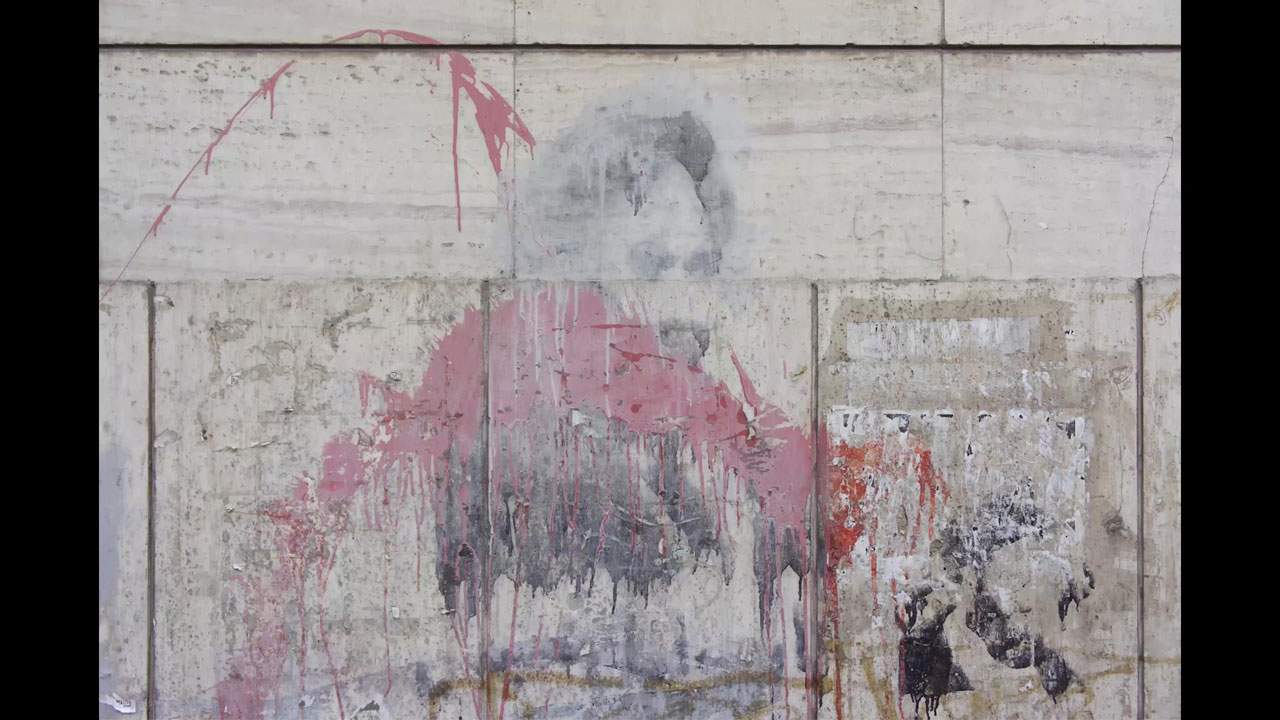 This is an ongoing project (2012 till now). The images are collected from more than twenty villages and towns. It was intended to be the least selective in the process of collecting, arranging and presenting the project; hence to make a record of part of what is seen on the streets in the current era.
This is an ongoing project (2012 till now). The images are collected from more than twenty villages and towns. It was intended to be the least selective in the process of collecting, arranging and presenting the project; hence to make a record of part of what is seen on the streets in the current era.
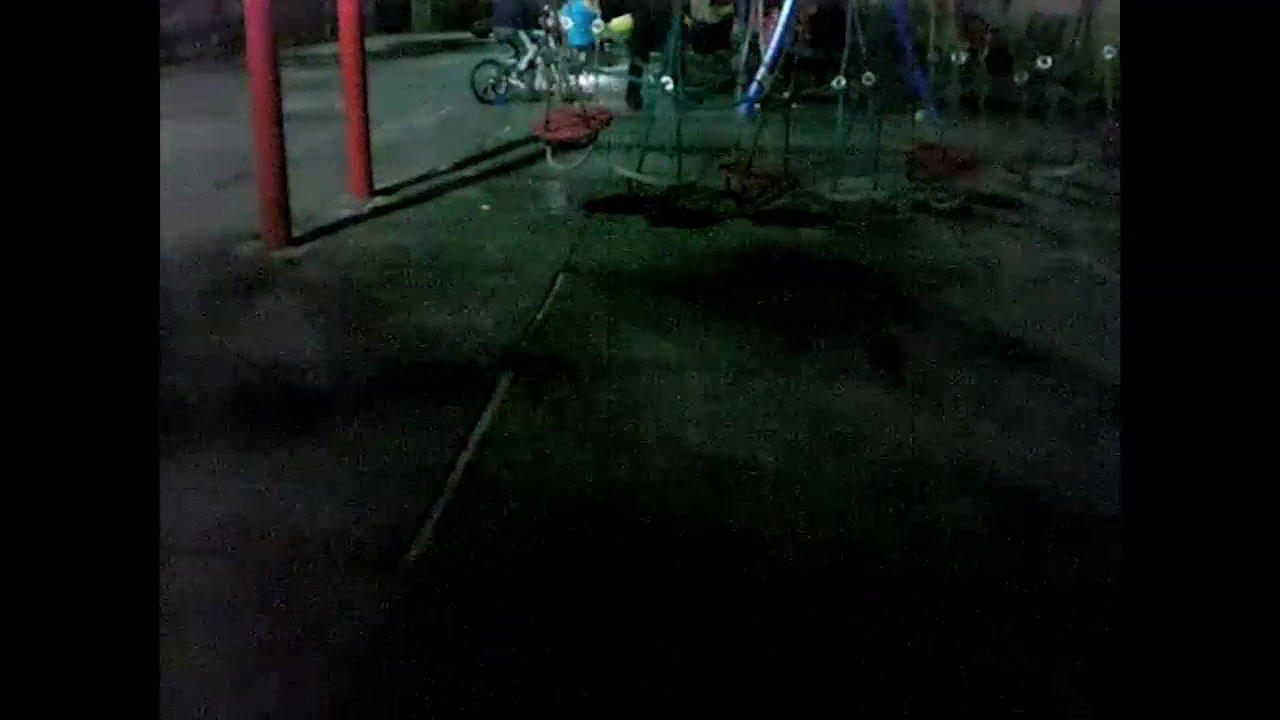 When I wander in Tehran, I observe very the same old things: streets, buildings, and people. But when I record images of the city with a camera, I come across a new city. my Camera lens distortions don’t allow me to take standard photos but looking at the distorted images gives me the image of a different city. I make my own city: The city I see is.
When I wander in Tehran, I observe very the same old things: streets, buildings, and people. But when I record images of the city with a camera, I come across a new city. my Camera lens distortions don’t allow me to take standard photos but looking at the distorted images gives me the image of a different city. I make my own city: The city I see is.
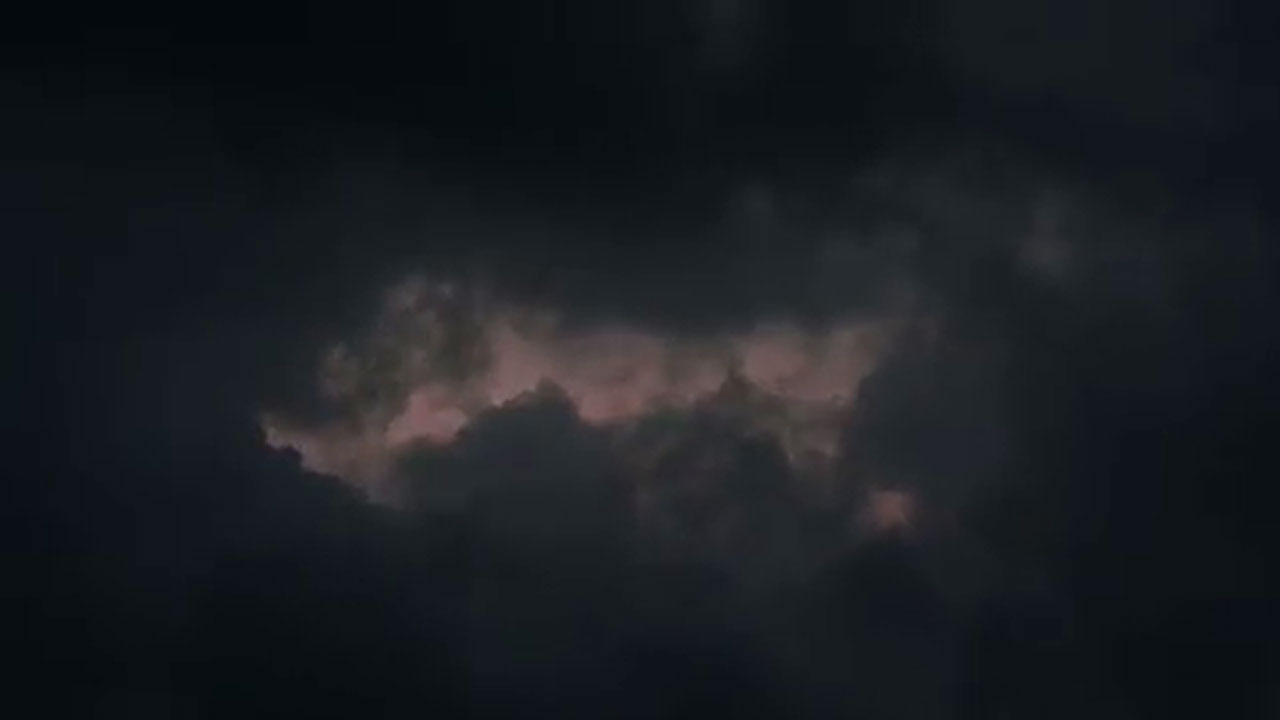 This film is part of an unfinished study project, in which I search for the interrelated semantic meaning between time and space.
This film is part of an unfinished study project, in which I search for the interrelated semantic meaning between time and space.
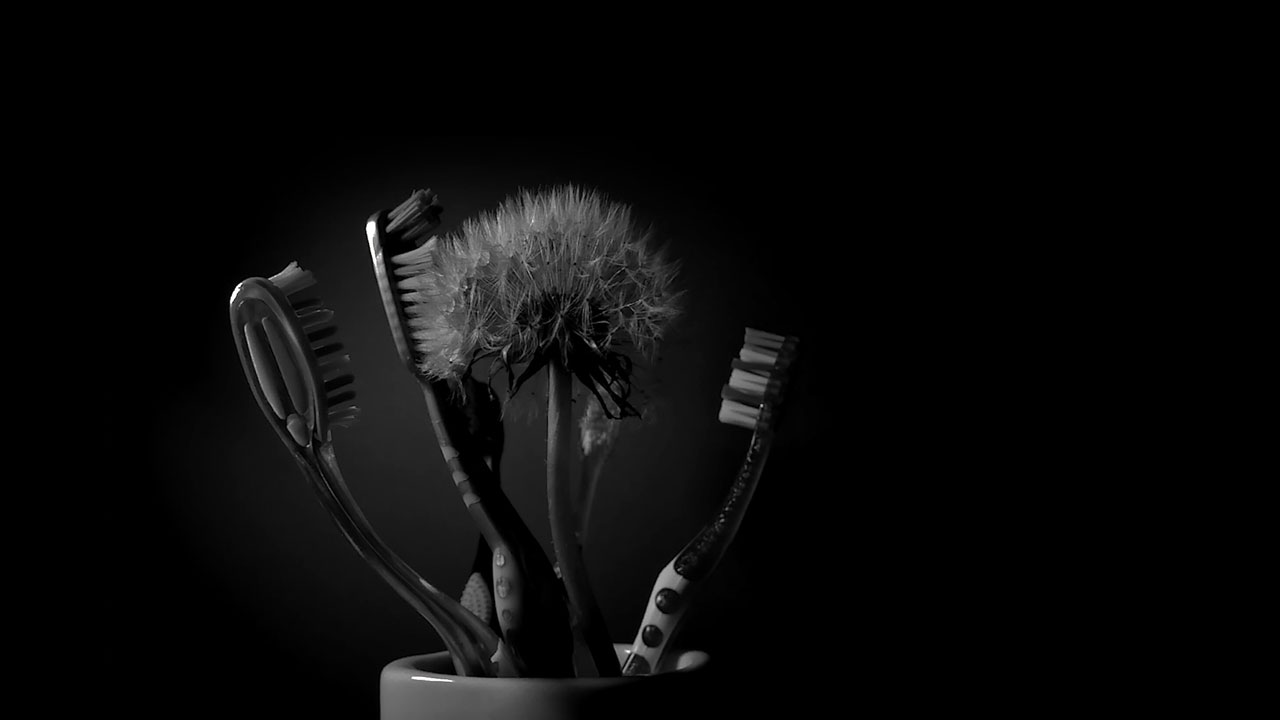 This collection includes some recorded images from the exterior and interior environments by time-lapse technique. This technique of photography gave me a new point regarding the surrounding changes.
This collection includes some recorded images from the exterior and interior environments by time-lapse technique. This technique of photography gave me a new point regarding the surrounding changes.
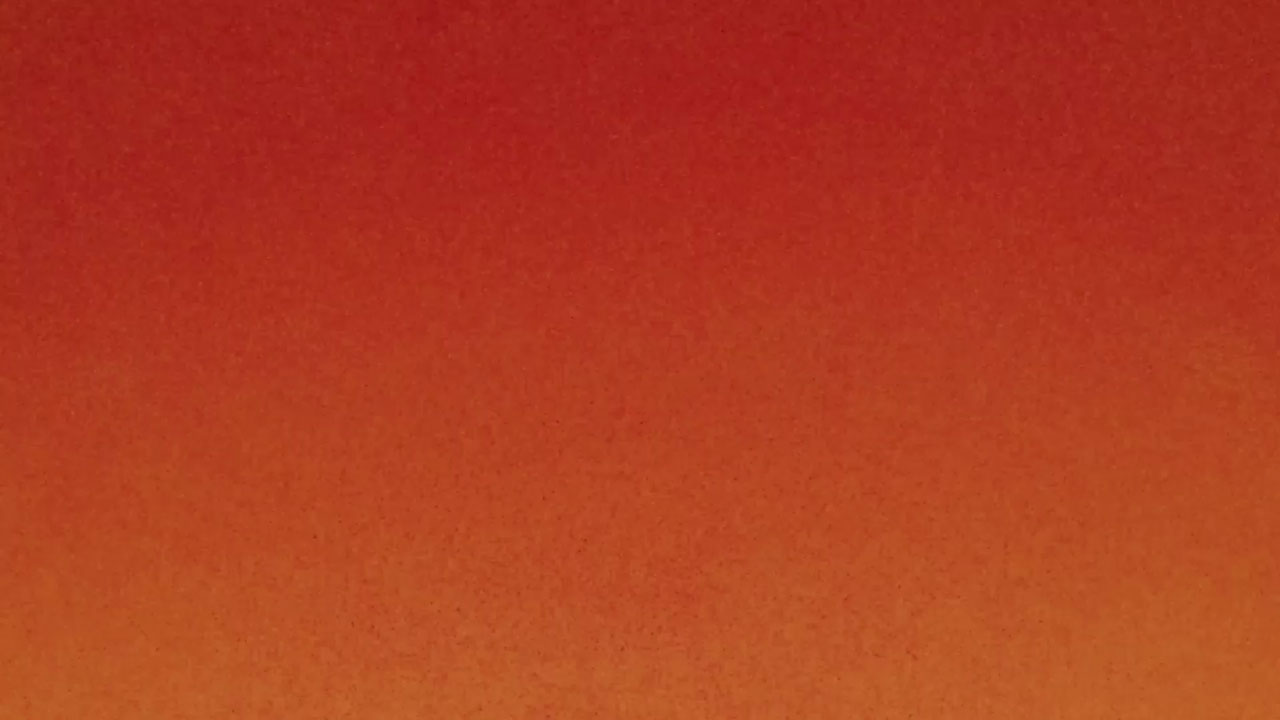 Karun is the longest river with freshwater in Iran. As the river passes by Ahvaz city center it has made an imaginative connection between locals there and the river, this connection has a big role in the formation of people’s emotions, feelings and loving. each person of the city has built its dignity along this riverside following with the songs which have been sung after the name of “Karun”. Ahvaz is the most polluted city in this country. Karun River is also polluted. There are 13 locations which discharge the sewage of Ahvaz city into Karun River. The shallow water of this river does not have enough capacity to contain a large volume of these polluted wastes. The smell of wastewater felt in the city and walking along the river is not allowed Discharge of urban and industrial sewage’s and agricultural and hospital sewage waters in Karun River has a direct impact on water quality of this river, so in the most days of the year, the water of this river is useless. The shallow water of this river does not have enough capacity to contain a large volume of these polluted wastes. The drinking water of Ahvaz city is provided from Karun River.
Karun is the longest river with freshwater in Iran. As the river passes by Ahvaz city center it has made an imaginative connection between locals there and the river, this connection has a big role in the formation of people’s emotions, feelings and loving. each person of the city has built its dignity along this riverside following with the songs which have been sung after the name of “Karun”. Ahvaz is the most polluted city in this country. Karun River is also polluted. There are 13 locations which discharge the sewage of Ahvaz city into Karun River. The shallow water of this river does not have enough capacity to contain a large volume of these polluted wastes. The smell of wastewater felt in the city and walking along the river is not allowed Discharge of urban and industrial sewage’s and agricultural and hospital sewage waters in Karun River has a direct impact on water quality of this river, so in the most days of the year, the water of this river is useless. The shallow water of this river does not have enough capacity to contain a large volume of these polluted wastes. The drinking water of Ahvaz city is provided from Karun River.
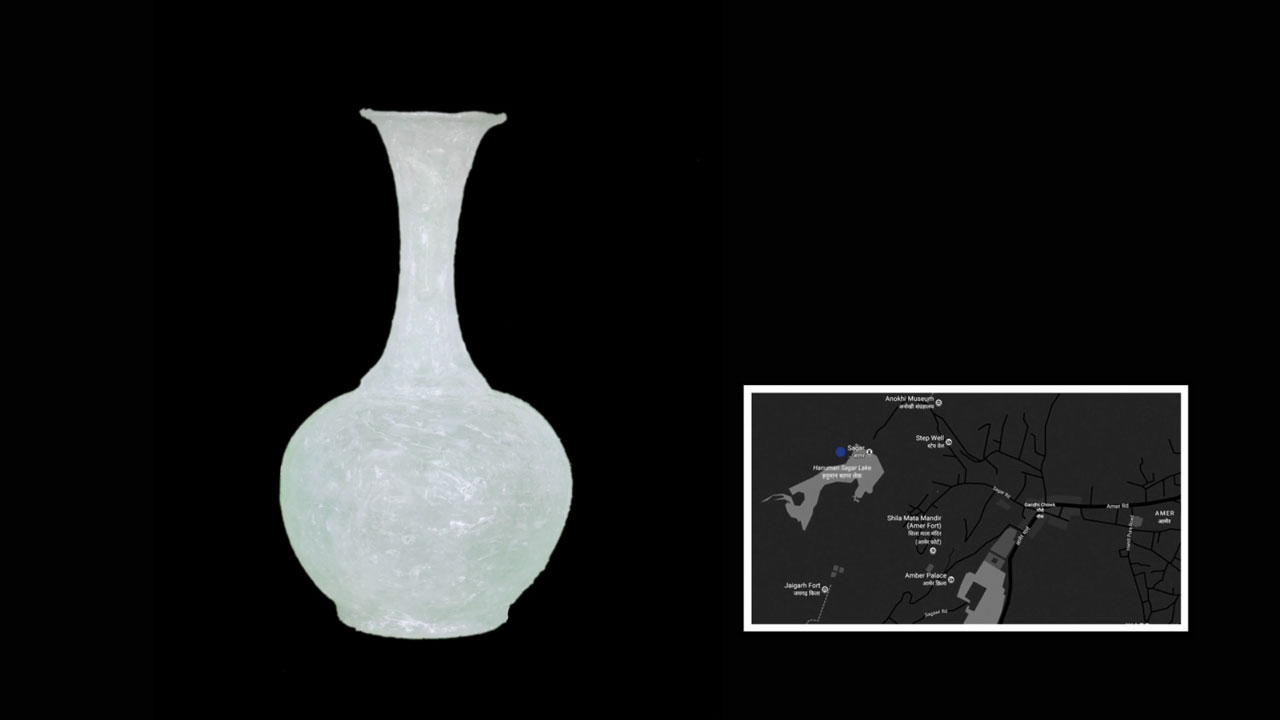 The present video demonstrates the process of carrying water within a container, a vessel. This process is replicated following a few different paths, each presented as a distinct story. The camera is mounted on/within the container, as though ‘water’ is the historical witness of the process of delivery. The handmade objects are the vessels in which the water in the video stories is carried. These vessels are made of a flexible, transparent material so that, instead of water taking the shape of the vessels, it is in fact water itself that forms the vessels (once more highlighting the active agency of water, from whose viewpoint we are watching the stories of delivery). The paths are demonstrated on an actual map of the local area, Jaipur, India.
The present video demonstrates the process of carrying water within a container, a vessel. This process is replicated following a few different paths, each presented as a distinct story. The camera is mounted on/within the container, as though ‘water’ is the historical witness of the process of delivery. The handmade objects are the vessels in which the water in the video stories is carried. These vessels are made of a flexible, transparent material so that, instead of water taking the shape of the vessels, it is in fact water itself that forms the vessels (once more highlighting the active agency of water, from whose viewpoint we are watching the stories of delivery). The paths are demonstrated on an actual map of the local area, Jaipur, India.
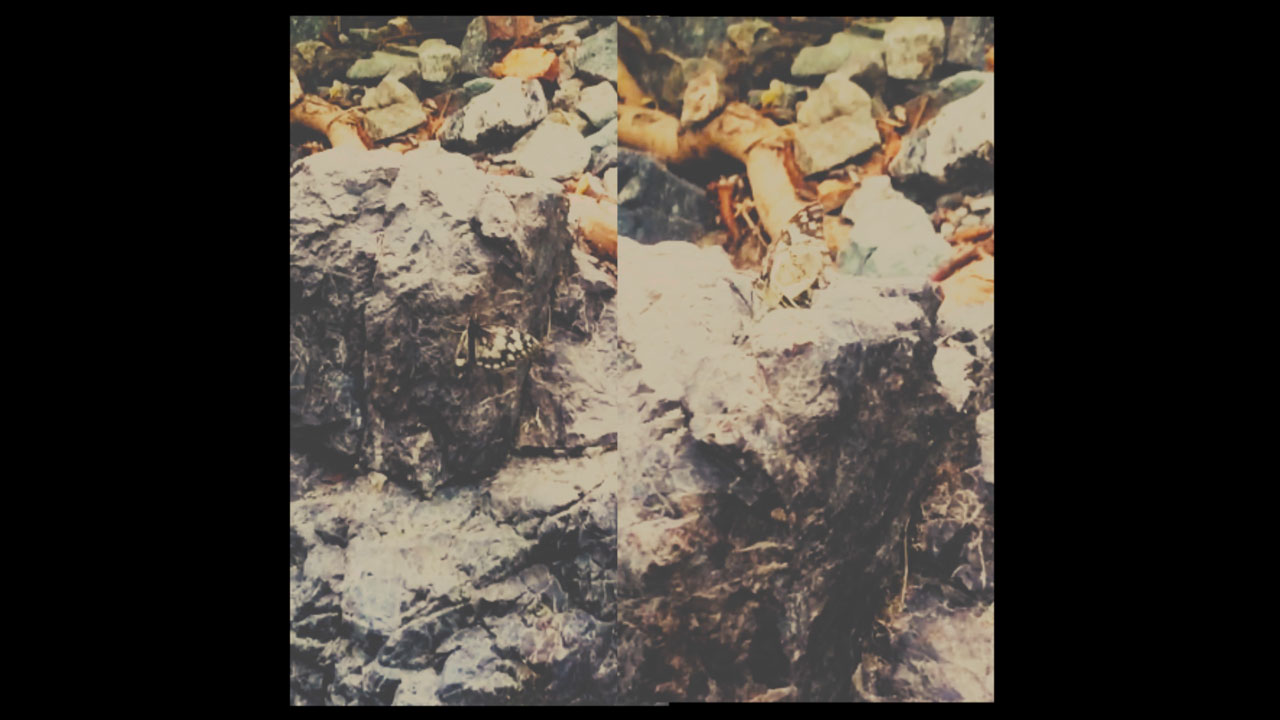 Here is Tehran, May 2019, Velenjak St., and I am here.
Here is Tehran, May 2019, Velenjak St., and I am here.
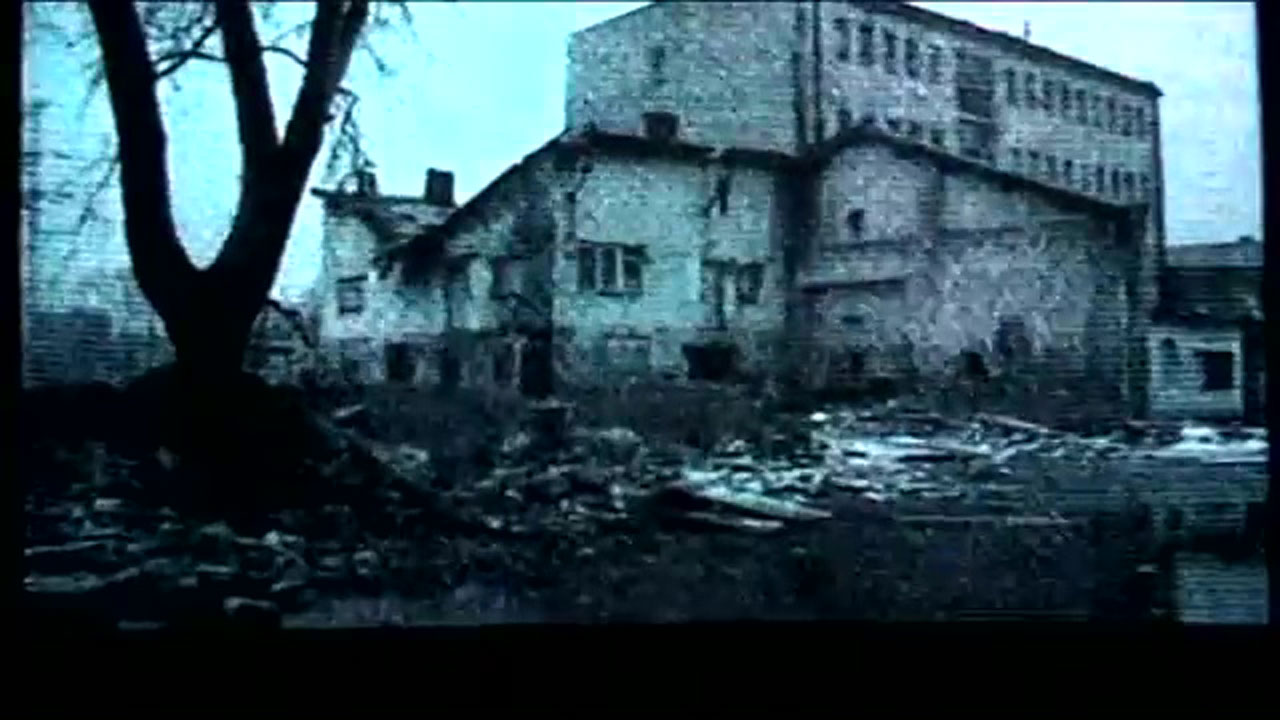 The video is about love and beginning a new life. I made it while I was in Goa, India.
The video is about love and beginning a new life. I made it while I was in Goa, India.
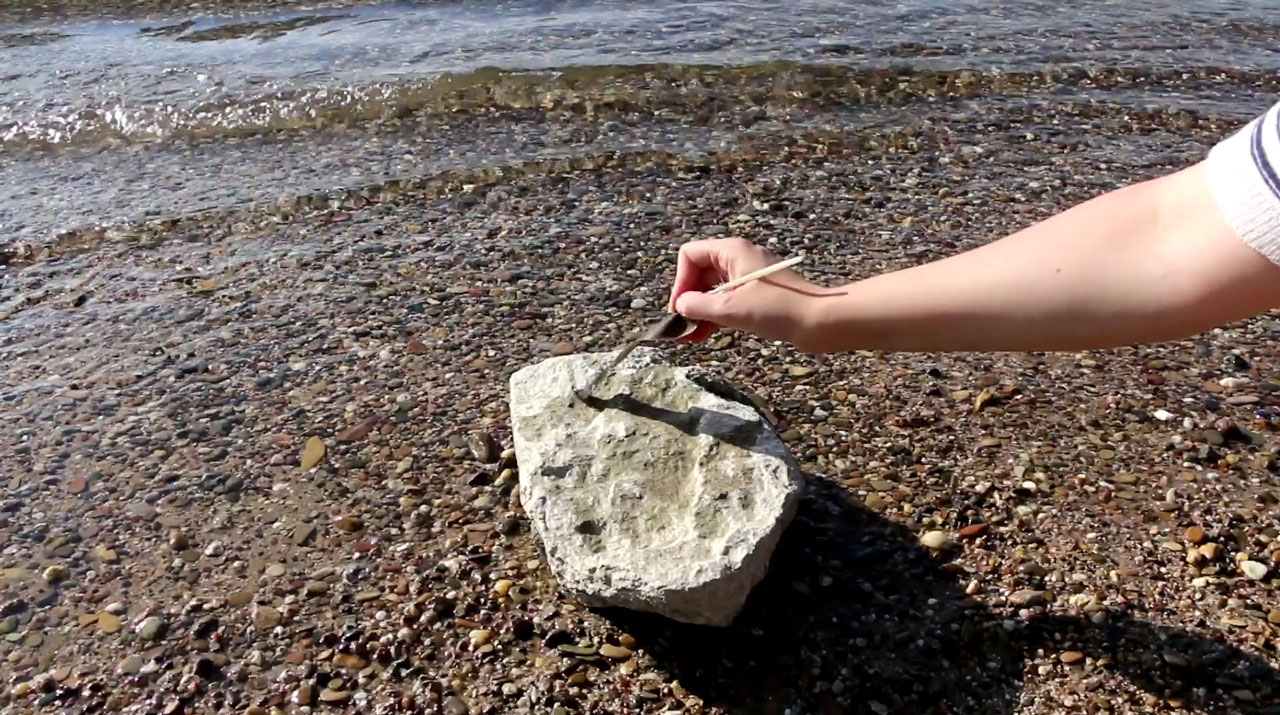 I write: Freedom – Rhine river, Germany
I write: Freedom – Rhine river, Germany
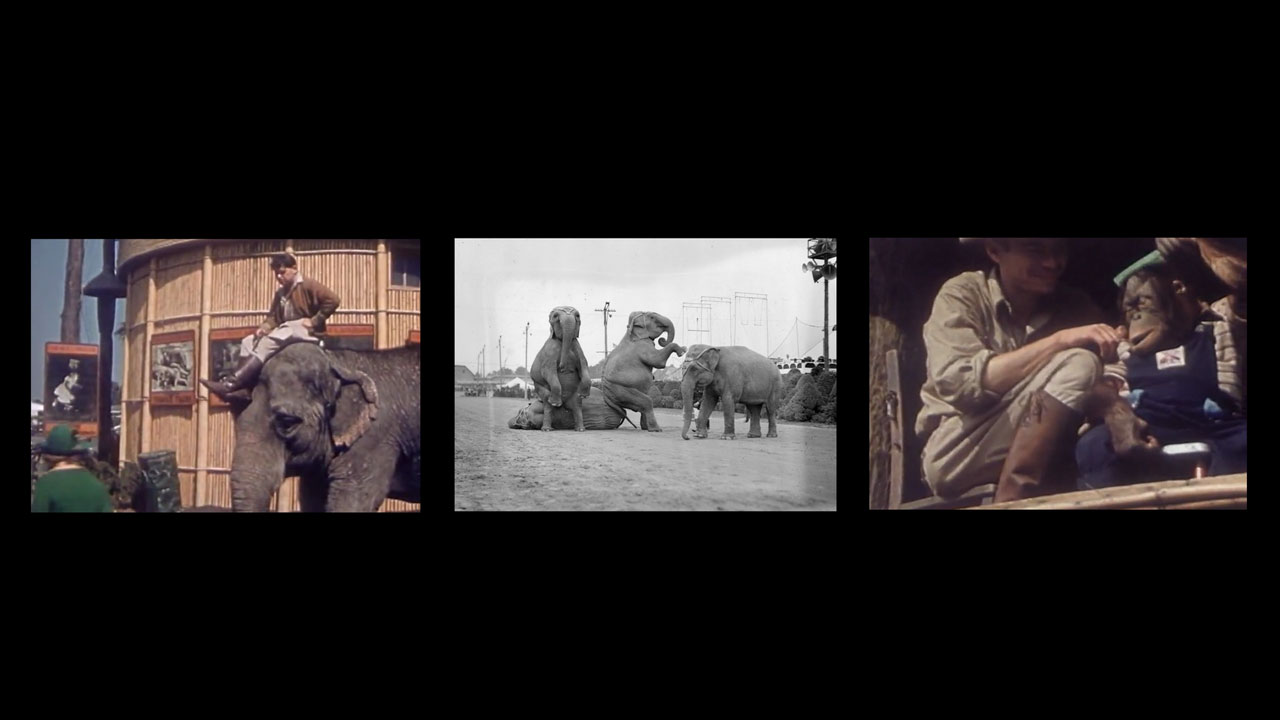 Bring Them Back Alive explores the advancement of the colonial project with the opening of the Suez Canal in 1869 — wherein flora, fauna and human beings were uprooted and transferred across multiple continents — and highlights a sinister, even surreal, pattern of domination. Found footage and photographs of botanical and zoological gardens, natural history museums and world fairs are intricately woven with the artist’s own photographic series on Egypt’s 125-year-old Giza Zoo.
Bring Them Back Alive explores the advancement of the colonial project with the opening of the Suez Canal in 1869 — wherein flora, fauna and human beings were uprooted and transferred across multiple continents — and highlights a sinister, even surreal, pattern of domination. Found footage and photographs of botanical and zoological gardens, natural history museums and world fairs are intricately woven with the artist’s own photographic series on Egypt’s 125-year-old Giza Zoo.
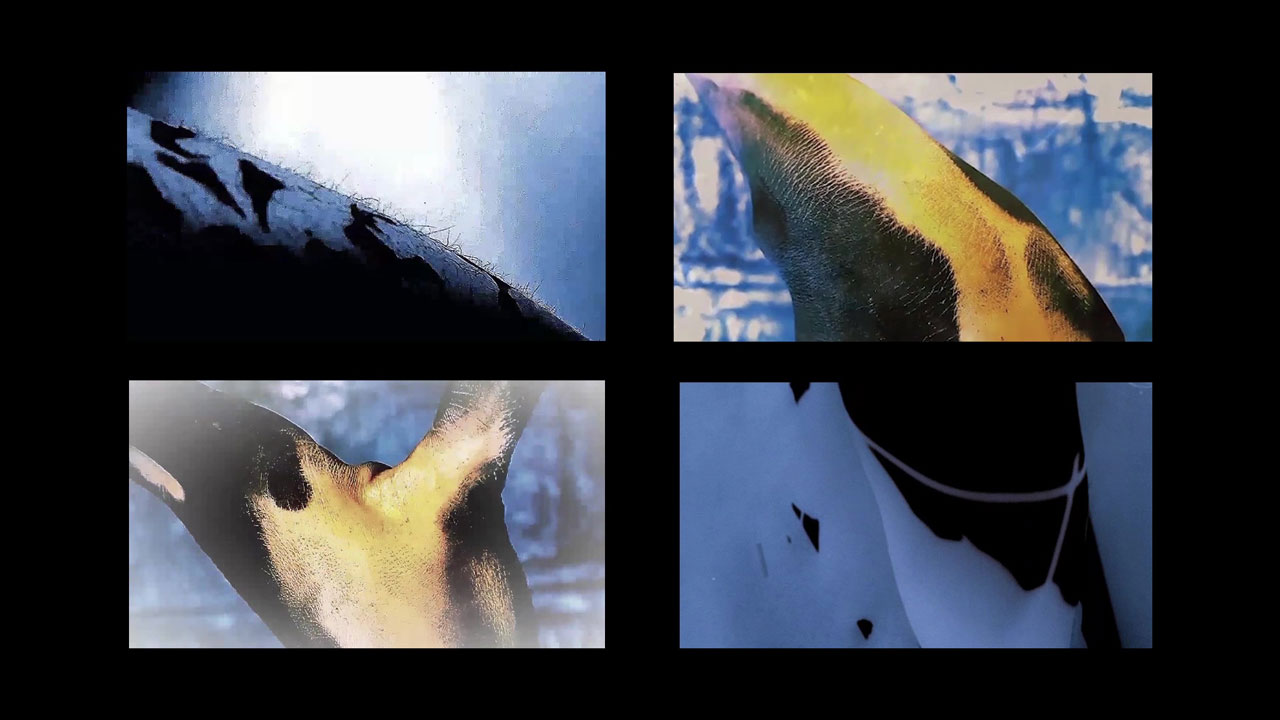 My work is a four-channel video installation. the video is displayed in four equal frames side by side. The size of the frame is 25 * 18 cm. The videos are muted and looped. This work is part of my bachelor’s thesis in painting. Its subject is the human skin, marks , and scratches that appear in different shapes in different people. The skin delineates and encircles the body as if it was a boundary between the inside and the outside of each human being. Besides, it is very flexible. On one hand, our exposure to the outside world is portrayed through the skin memory, because the marks on it narrate a story, historical stories ranging from congenital signs to traumatic ones remained from to an accident and etc.
My work is a four-channel video installation. the video is displayed in four equal frames side by side. The size of the frame is 25 * 18 cm. The videos are muted and looped. This work is part of my bachelor’s thesis in painting. Its subject is the human skin, marks , and scratches that appear in different shapes in different people. The skin delineates and encircles the body as if it was a boundary between the inside and the outside of each human being. Besides, it is very flexible. On one hand, our exposure to the outside world is portrayed through the skin memory, because the marks on it narrate a story, historical stories ranging from congenital signs to traumatic ones remained from to an accident and etc.
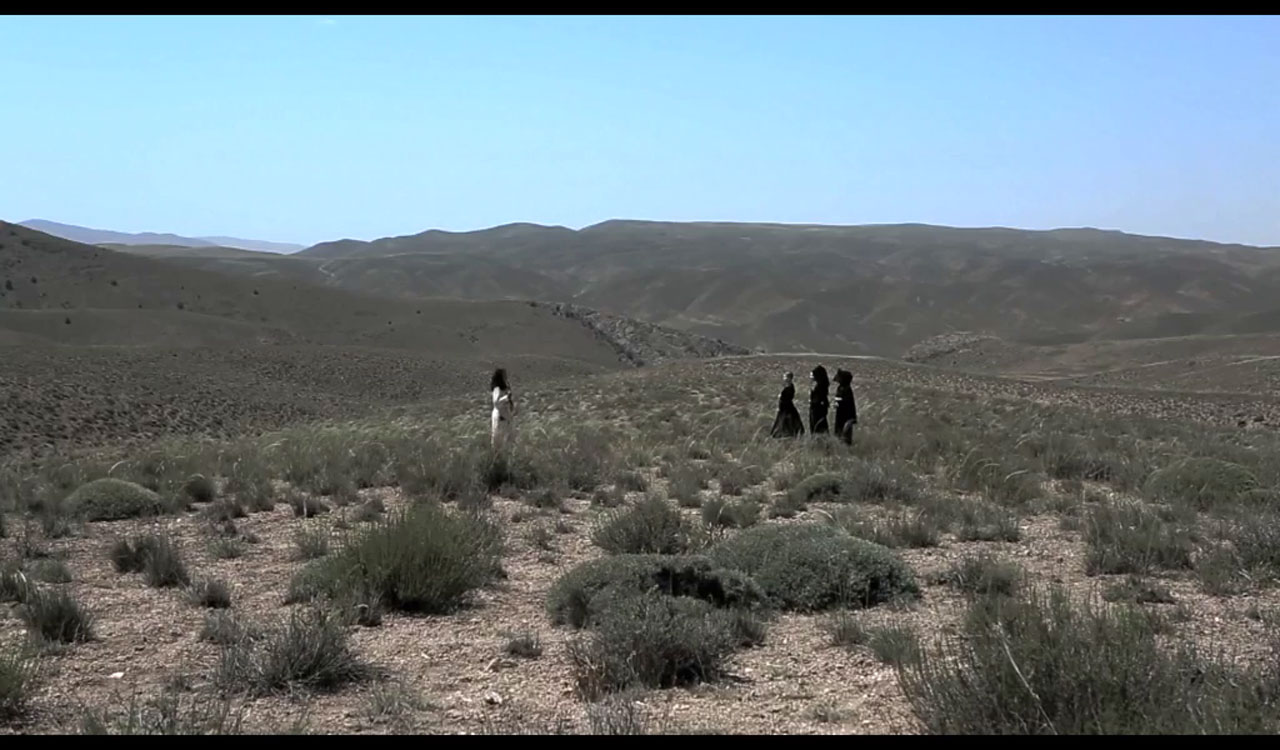 The Scarecrow is my mirror, full of characteristics and roles that fill all the moments of my everyday womanly life. “The Scarecrow and Me” are built by the others, always with a role saved for us: The guardian of the Earth and fertility for me and the scarecrow, and the guardian of husband, child and family life for me alone. We’re both destined to guard something, and this brings us stagnation, and stagnation brings us depression and lethargy. The scarecrow and me, we’re full of paradoxes. Sometimes we love, sometimes we don’t, sometimes we laugh, and sometimes we don’t. Sometimes we just stare into the distance, and a deadly routine surrounds our every moment. Sometimes we think of putting up a fight, with ourselves, with another or the others, with traditions that enchain us, with womanly routines, with all the commodities circling us. But now, we’re not just thinking, because we’ve been called to arms, we’re called to move, to act, to go… regardless of all these things that enchain us.
The Scarecrow is my mirror, full of characteristics and roles that fill all the moments of my everyday womanly life. “The Scarecrow and Me” are built by the others, always with a role saved for us: The guardian of the Earth and fertility for me and the scarecrow, and the guardian of husband, child and family life for me alone. We’re both destined to guard something, and this brings us stagnation, and stagnation brings us depression and lethargy. The scarecrow and me, we’re full of paradoxes. Sometimes we love, sometimes we don’t, sometimes we laugh, and sometimes we don’t. Sometimes we just stare into the distance, and a deadly routine surrounds our every moment. Sometimes we think of putting up a fight, with ourselves, with another or the others, with traditions that enchain us, with womanly routines, with all the commodities circling us. But now, we’re not just thinking, because we’ve been called to arms, we’re called to move, to act, to go… regardless of all these things that enchain us.
Forum B
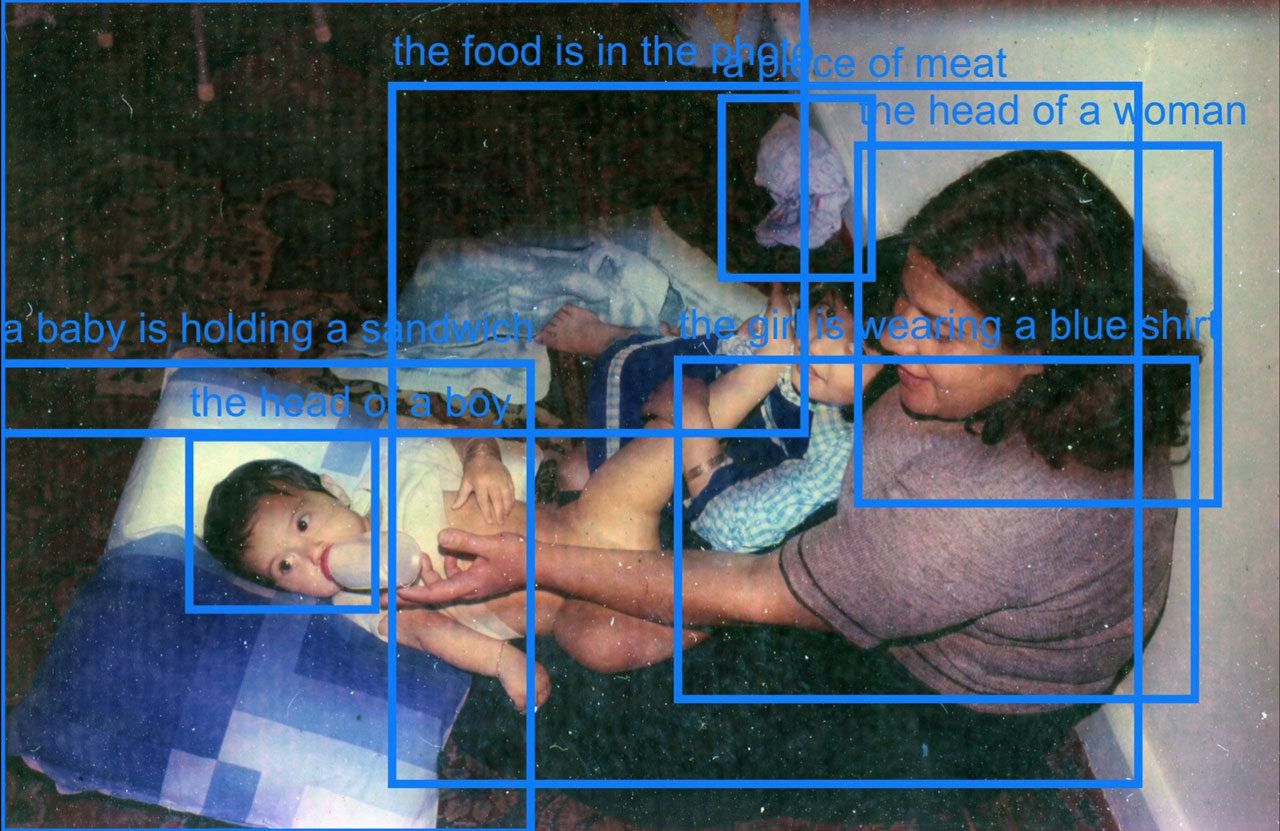 The found collection of slides, from those I do not know, are identified by the capability of artificial intelligence trying to recognize the image, on top of a layer of the recorded voices of my childhood.
The found collection of slides, from those I do not know, are identified by the capability of artificial intelligence trying to recognize the image, on top of a layer of the recorded voices of my childhood.
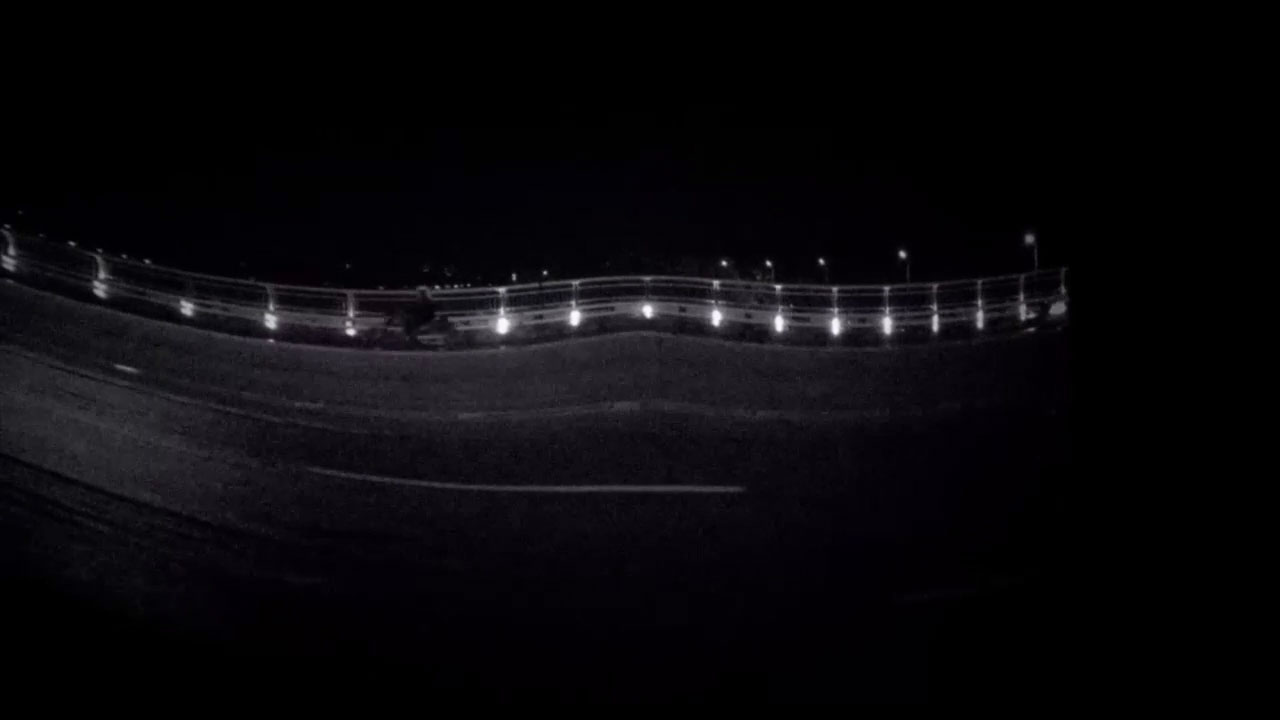 Under the moonlighting a blink of an eye, You’ve realized that years, days, hours, seconds and many feelings are hidden behind you and now you’re the guardian of a secret much bigger than all the incidents of your life. You’re the connector; the connector of all these moments and memories. Moon will shine to me till eternity. While I was thinking that time is frozen in my world, actually no time was there. From a moment onward, nothing needs justification. All of them are reminders, though they’re provisional, they’re sufficient for my existence. Yet there’s fear in me, pain is still there, but I can shout. These images and murmurs are my soul’s endeavor to express something beyond my tolerance. We shout we suffer, We get wounded in our minds, We keep our wounds folded and closed while being beside others, In the darkness, wounds will open, Dirt and blood and cry will get out of them. To die, to scratch, Nothing comes out of nothingness, Explore, A fear before me finishing itself.
Under the moonlighting a blink of an eye, You’ve realized that years, days, hours, seconds and many feelings are hidden behind you and now you’re the guardian of a secret much bigger than all the incidents of your life. You’re the connector; the connector of all these moments and memories. Moon will shine to me till eternity. While I was thinking that time is frozen in my world, actually no time was there. From a moment onward, nothing needs justification. All of them are reminders, though they’re provisional, they’re sufficient for my existence. Yet there’s fear in me, pain is still there, but I can shout. These images and murmurs are my soul’s endeavor to express something beyond my tolerance. We shout we suffer, We get wounded in our minds, We keep our wounds folded and closed while being beside others, In the darkness, wounds will open, Dirt and blood and cry will get out of them. To die, to scratch, Nothing comes out of nothingness, Explore, A fear before me finishing itself.
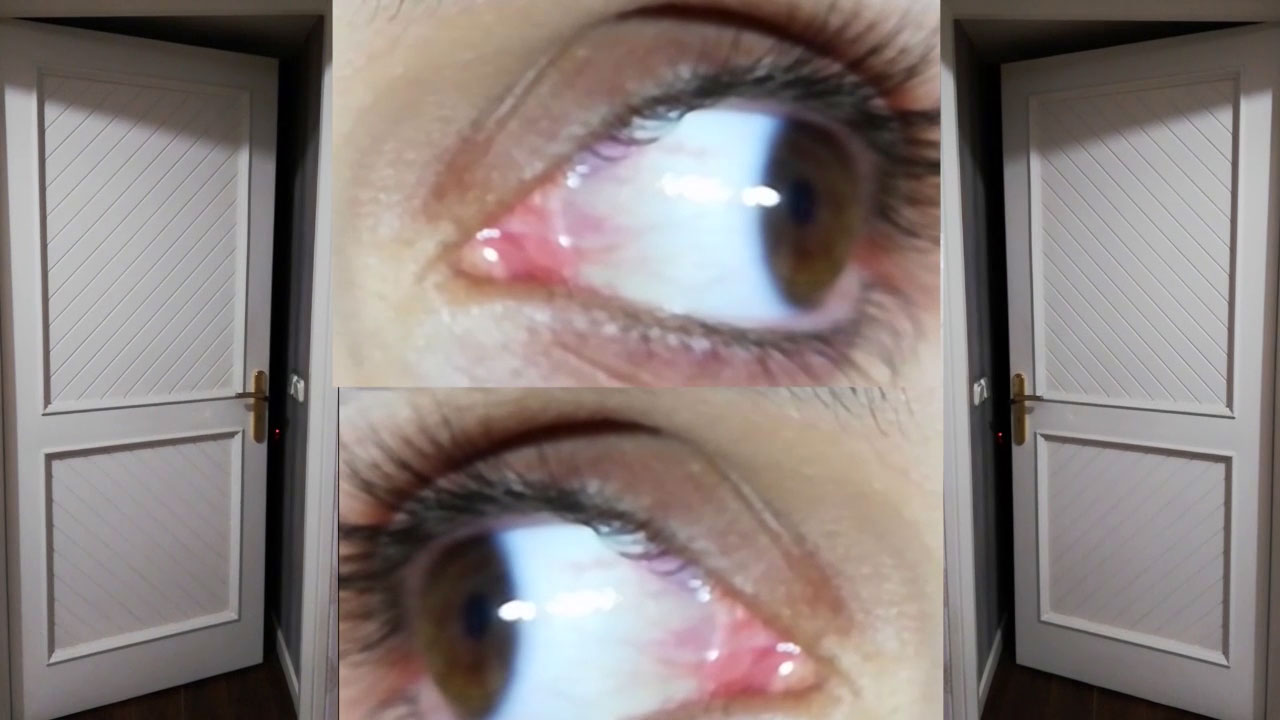 In my idea door viewers in every house have a story to tell. We can see outside the door but people who are outside the door and walking in the stairs can’t see us. They just sense that someone is looking at them or watching them. I want to show the mystery of loneliness in the stairs and also not knowing about what happens before and after that specific moment which you can observe from the door viewer.
In my idea door viewers in every house have a story to tell. We can see outside the door but people who are outside the door and walking in the stairs can’t see us. They just sense that someone is looking at them or watching them. I want to show the mystery of loneliness in the stairs and also not knowing about what happens before and after that specific moment which you can observe from the door viewer.
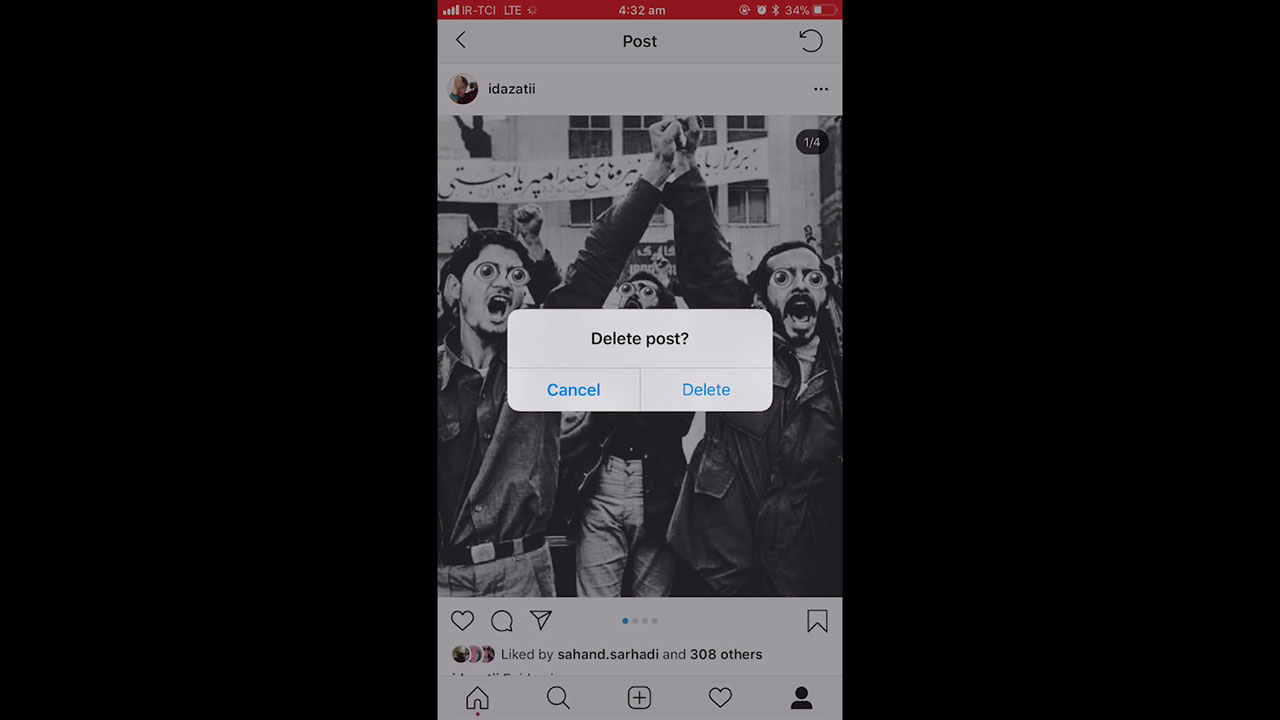 At the very moment that a post is shared on social media and shows up on other people’s feeds, seeing and interacting with it may lead to a subjective feeling of authority over the post in the viewer, a feeling which is nonidentical from the first person’s. Now, if all that had been one day shared, suddenly removed; would the other’s feeling of authority over that particular post be damaged? Or is it the very first person who still owns the authority over it?
At the very moment that a post is shared on social media and shows up on other people’s feeds, seeing and interacting with it may lead to a subjective feeling of authority over the post in the viewer, a feeling which is nonidentical from the first person’s. Now, if all that had been one day shared, suddenly removed; would the other’s feeling of authority over that particular post be damaged? Or is it the very first person who still owns the authority over it?
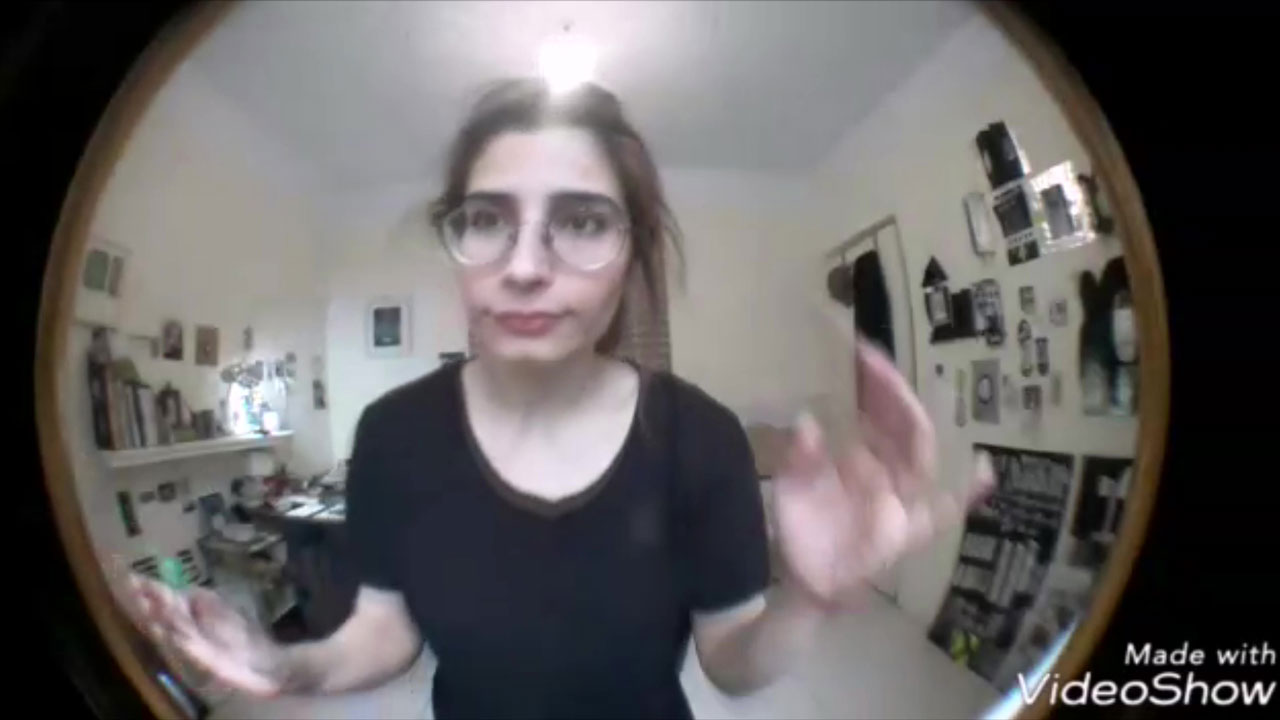 There are always things that remain covered.
There are always things that remain covered.
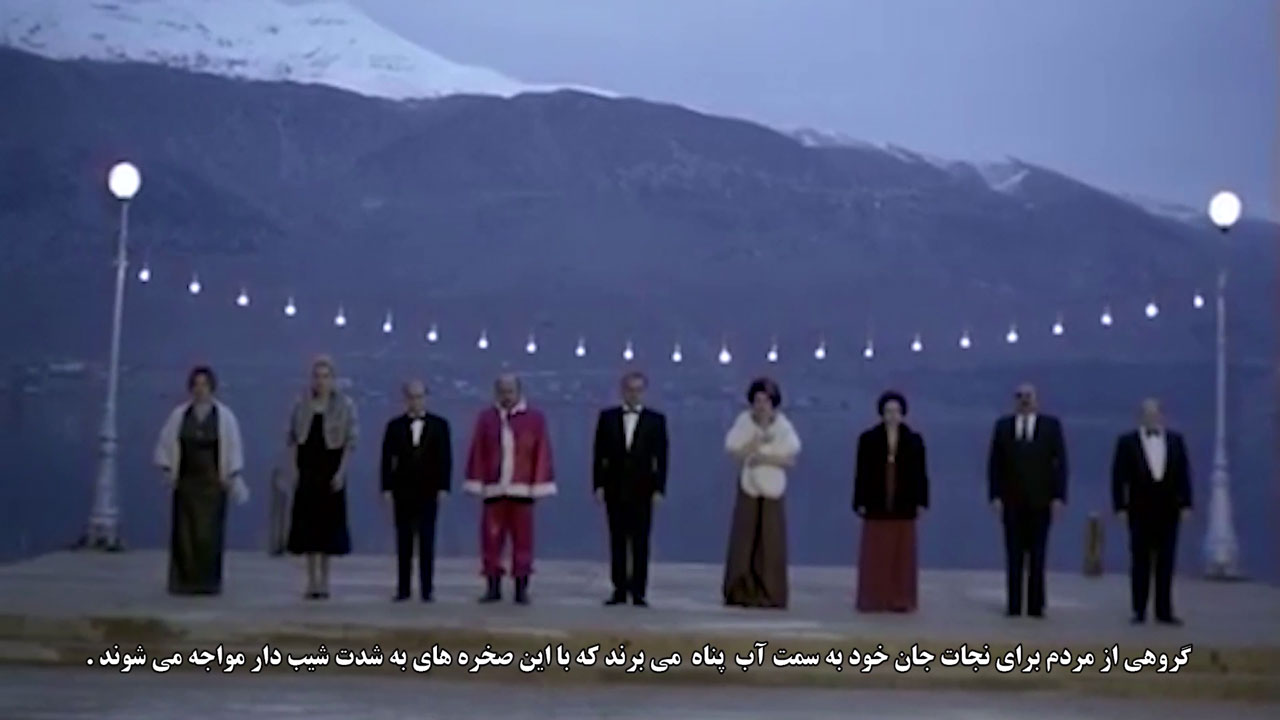 1 . The house and private archives of Greek director Theo Angelopoulos were destroyed in deadly wildfires near Athens, his books, his letters from celebrities, all the texts that authors had dedicated to him were destroyed in the fire the collection had also included texts and poems written by him. 2. More than 80 people have been killed after Greece’s worst wildfire in a decade hit the small resort of Mati, 18 miles east of Athens. Greek reports suggested that 1,500 homes had been damaged, with many destroyed. At least 187 people were injured, officials said, among those 23 children. Which one of these will make the headlines? Which one will make history? Which one will be retold by the historians? Which one will make the people of Greece sorrowful when talking about the fire 100 years from now? Would it be important if Angelopoulos’s house was not burned in this fire? Would this tragedy that burned and destroyed 1000 houses and killed 80 people recorded in history if Angelopoulos’s poems were not turned to ashes? These are the questions that lead us to create this artwork… * ( This video art includes two videos with the same length of time that are played simultaneously in front of each other. the sounds of videos are exchanged. The sound of the movies is on the video of the news and the sound of news is on the movies.)
1 . The house and private archives of Greek director Theo Angelopoulos were destroyed in deadly wildfires near Athens, his books, his letters from celebrities, all the texts that authors had dedicated to him were destroyed in the fire the collection had also included texts and poems written by him. 2. More than 80 people have been killed after Greece’s worst wildfire in a decade hit the small resort of Mati, 18 miles east of Athens. Greek reports suggested that 1,500 homes had been damaged, with many destroyed. At least 187 people were injured, officials said, among those 23 children. Which one of these will make the headlines? Which one will make history? Which one will be retold by the historians? Which one will make the people of Greece sorrowful when talking about the fire 100 years from now? Would it be important if Angelopoulos’s house was not burned in this fire? Would this tragedy that burned and destroyed 1000 houses and killed 80 people recorded in history if Angelopoulos’s poems were not turned to ashes? These are the questions that lead us to create this artwork… * ( This video art includes two videos with the same length of time that are played simultaneously in front of each other. the sounds of videos are exchanged. The sound of the movies is on the video of the news and the sound of news is on the movies.)
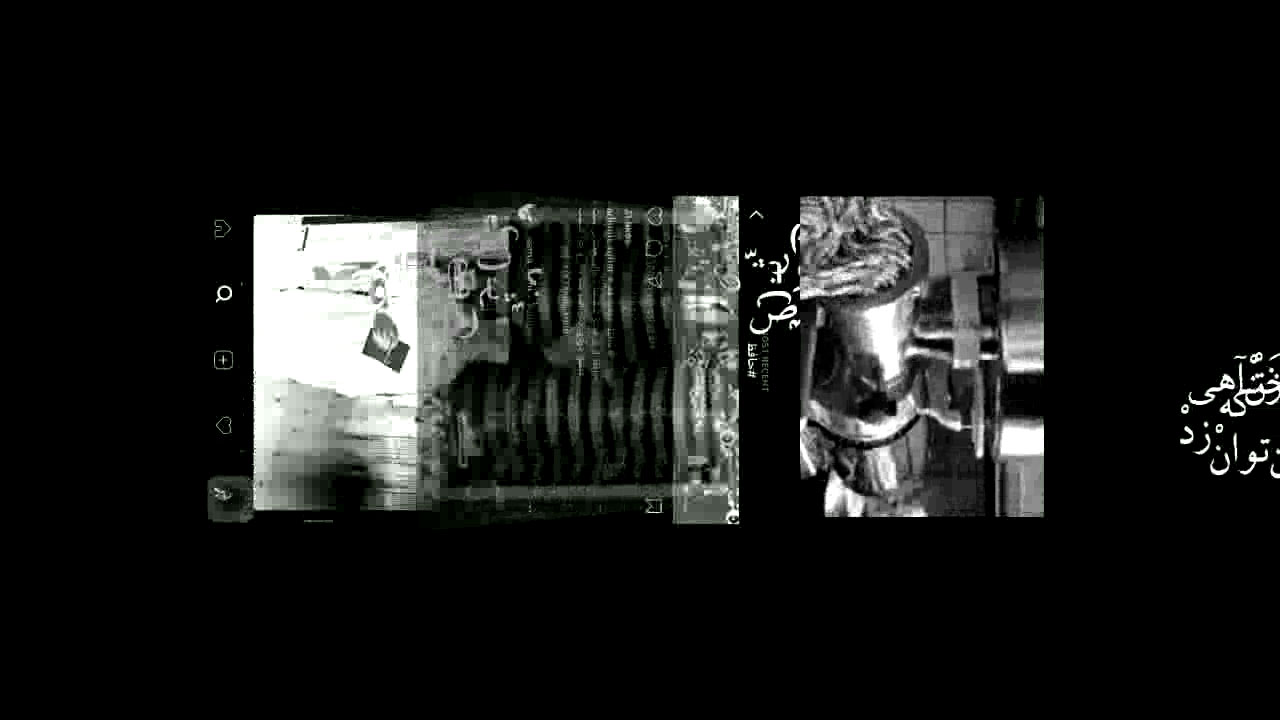 They are everywhere; in whatever you think about, whatever you see, whatever you hear… The three-phase cycle of production, distribution, and consumption starts running. It swallows all the letters, words and sentences. The setup intends to abstract out the meaning of words, and pass it through its referent to turn it to a sign. the Signs the social functions of which are predictable.
They are everywhere; in whatever you think about, whatever you see, whatever you hear… The three-phase cycle of production, distribution, and consumption starts running. It swallows all the letters, words and sentences. The setup intends to abstract out the meaning of words, and pass it through its referent to turn it to a sign. the Signs the social functions of which are predictable.
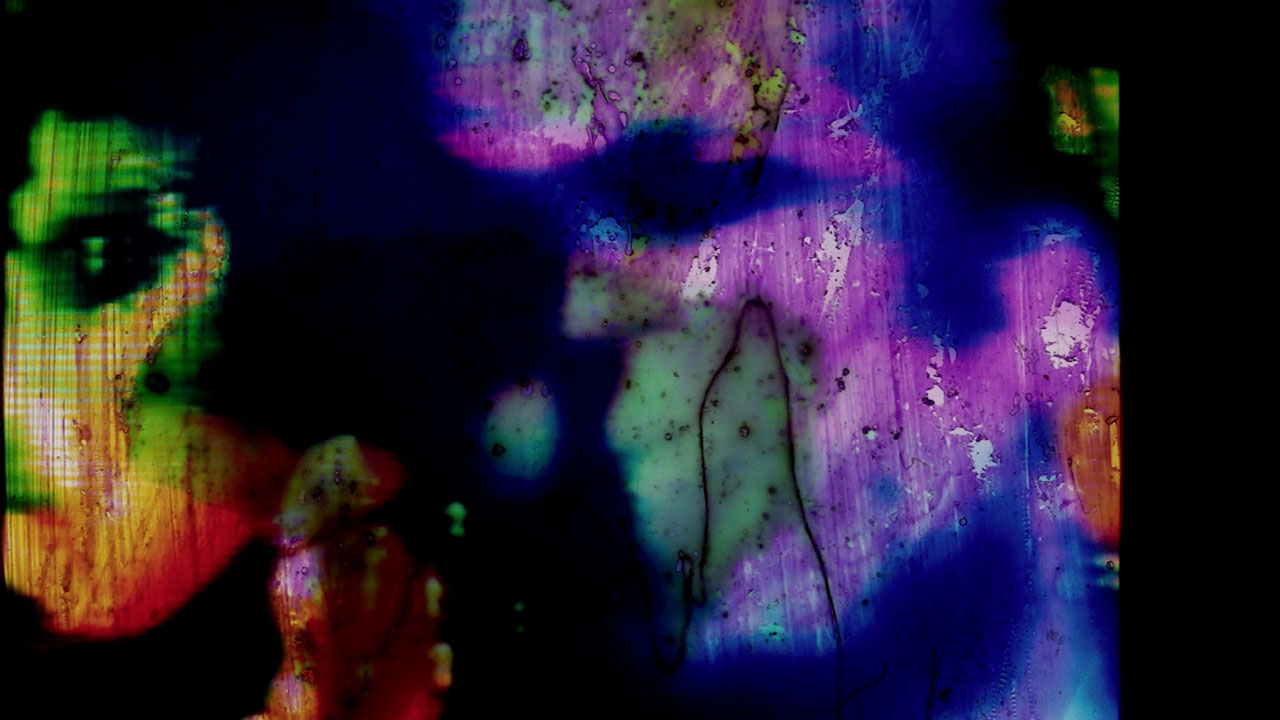 “Echo of Klaus Kinski’s broken dream, in the face of Werner Herzog’s multiple rejections to direct his script on the mad violinist Paganini. A psychedelic trance capturing the visions of a madman; traces of a film that could have existed.”
“Echo of Klaus Kinski’s broken dream, in the face of Werner Herzog’s multiple rejections to direct his script on the mad violinist Paganini. A psychedelic trance capturing the visions of a madman; traces of a film that could have existed.”
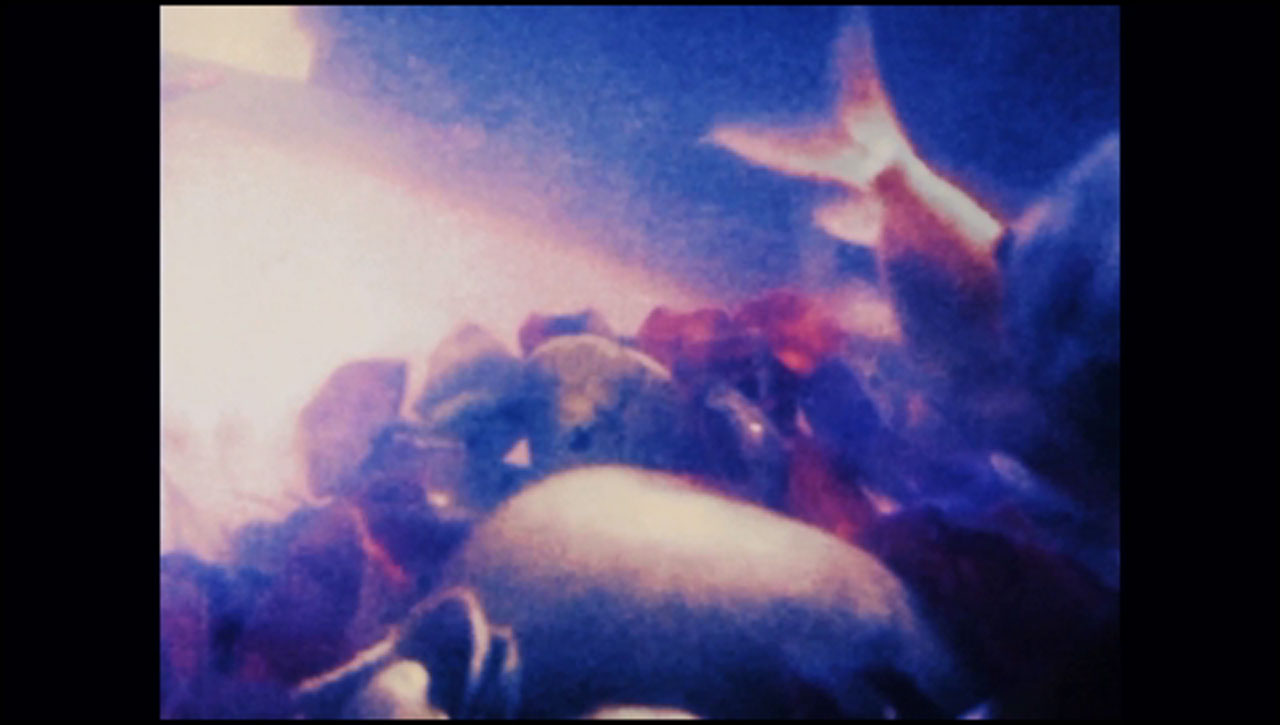 The more careful we get, the weirder the forms become.
The more careful we get, the weirder the forms become.
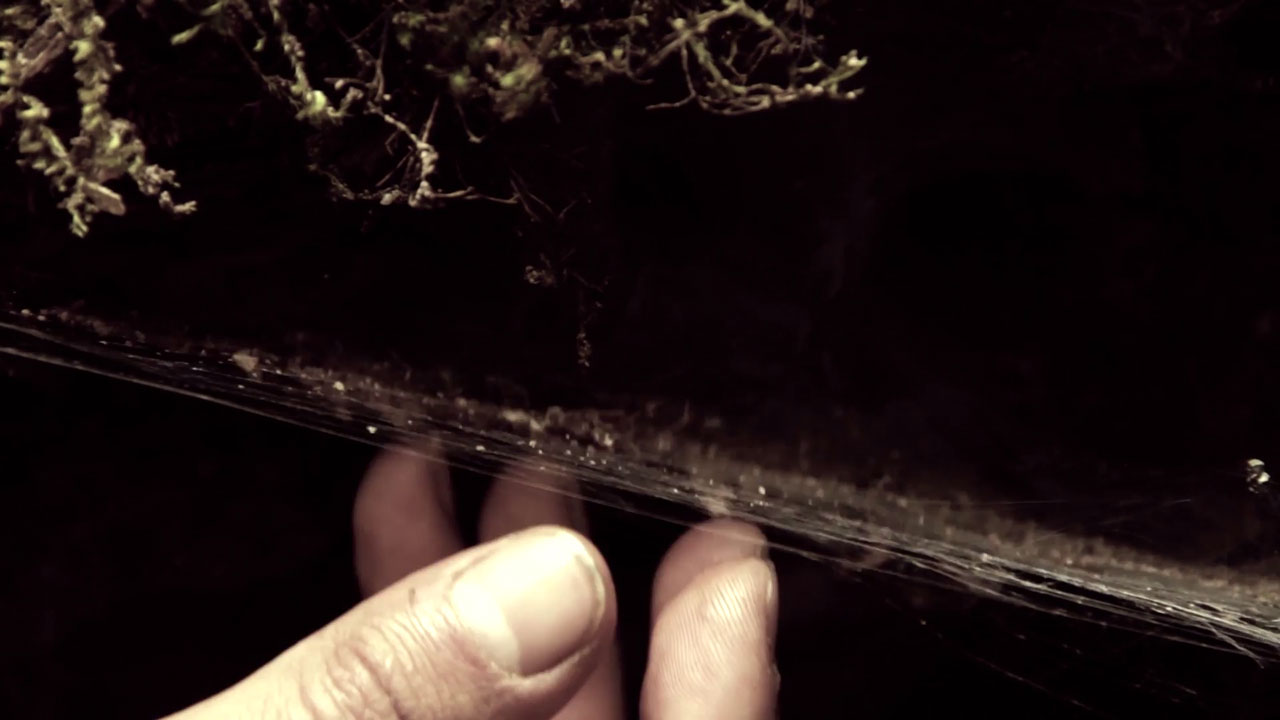 We were born in a holding moment of the history of the universe, we were put in measurements of circles and started to rotate with the turn of time to break down the mentality of the universe, but this fracture will reveal the feedback of its irregularities to us.
We were born in a holding moment of the history of the universe, we were put in measurements of circles and started to rotate with the turn of time to break down the mentality of the universe, but this fracture will reveal the feedback of its irregularities to us.
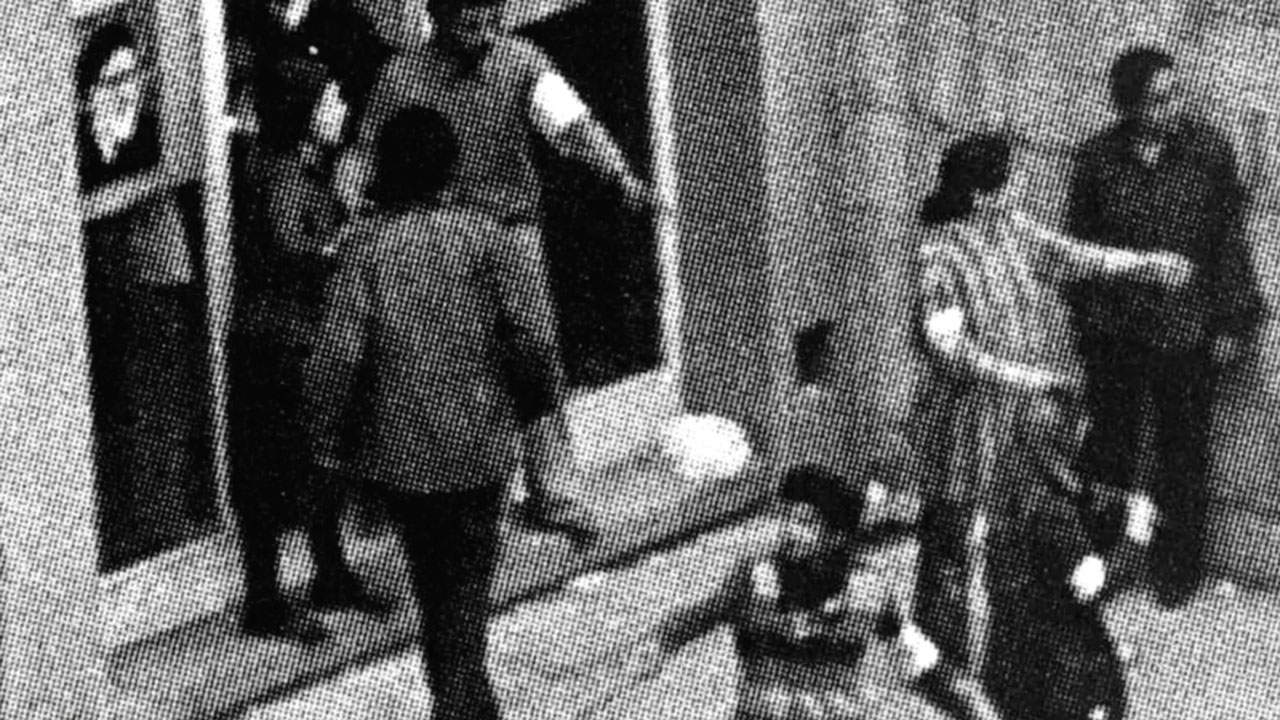 “Stage of History” is a stage or scene On which the History, or whatever we assume as events, personal or collective interactions of human beings, occurs. Can one associate a theater stage with the location that history takes place? What will be the situation if the hypothetical location of history is beside a theater venue? Can we ever show history in a place other than a classic theater scene? Which one of these two plays would as Aristotle said in Poetics, lead the audience of history towards catharsis. Are locations the agencies of the spirit of history and the happenings which occurred in them? To what extent the passage of years has enhanced the nature and spirit of locations. Where is the position of the audience in this play? The audience has the freedom to change their view towards every corner of the scene. They are free to choose between the real event (occurred history) and the symbolic event (theatre stage). We might claim that this is the movement of eyes that establishes a history.
“Stage of History” is a stage or scene On which the History, or whatever we assume as events, personal or collective interactions of human beings, occurs. Can one associate a theater stage with the location that history takes place? What will be the situation if the hypothetical location of history is beside a theater venue? Can we ever show history in a place other than a classic theater scene? Which one of these two plays would as Aristotle said in Poetics, lead the audience of history towards catharsis. Are locations the agencies of the spirit of history and the happenings which occurred in them? To what extent the passage of years has enhanced the nature and spirit of locations. Where is the position of the audience in this play? The audience has the freedom to change their view towards every corner of the scene. They are free to choose between the real event (occurred history) and the symbolic event (theatre stage). We might claim that this is the movement of eyes that establishes a history.
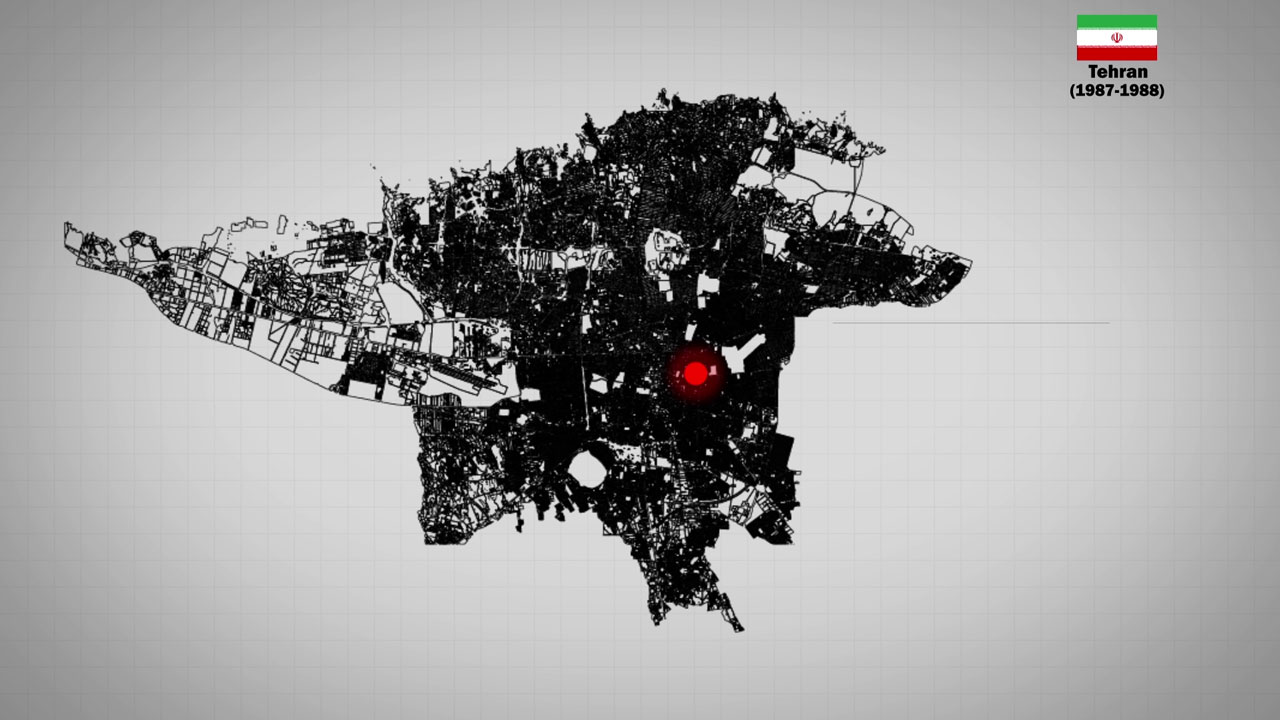 Let’s imagine the eighties, the city is slowly falling asleep, maybe some are praying for the soldiers, and perhaps the advantage of being in the capital has made them the feeling of being in the safe zone. In the meantime, the sky suddenly turns into an abyss. Homes, hospitals, schools, etc. are destroyed. War always imposes catastrophic consequences on its pros and those who are neutral, the old and the young, etc. the results are So terrifying that makes it impossible to imagine. Much has been said and documented about the Iran-Iraq war; many books have been written, and so on. But it seems like it is not going to end. The war experience has been so deep and lasting that there are many things unsaid. Here you see a small part of the bombing of the residential areas (which began February 7 to 22, 1984). It is known as The War of the Cities, based on a book written by Sasan Moayedi, titled “Tehran: 50 Days of War”. It is the only published book on this topic and is published by Soroush publication.
Let’s imagine the eighties, the city is slowly falling asleep, maybe some are praying for the soldiers, and perhaps the advantage of being in the capital has made them the feeling of being in the safe zone. In the meantime, the sky suddenly turns into an abyss. Homes, hospitals, schools, etc. are destroyed. War always imposes catastrophic consequences on its pros and those who are neutral, the old and the young, etc. the results are So terrifying that makes it impossible to imagine. Much has been said and documented about the Iran-Iraq war; many books have been written, and so on. But it seems like it is not going to end. The war experience has been so deep and lasting that there are many things unsaid. Here you see a small part of the bombing of the residential areas (which began February 7 to 22, 1984). It is known as The War of the Cities, based on a book written by Sasan Moayedi, titled “Tehran: 50 Days of War”. It is the only published book on this topic and is published by Soroush publication.
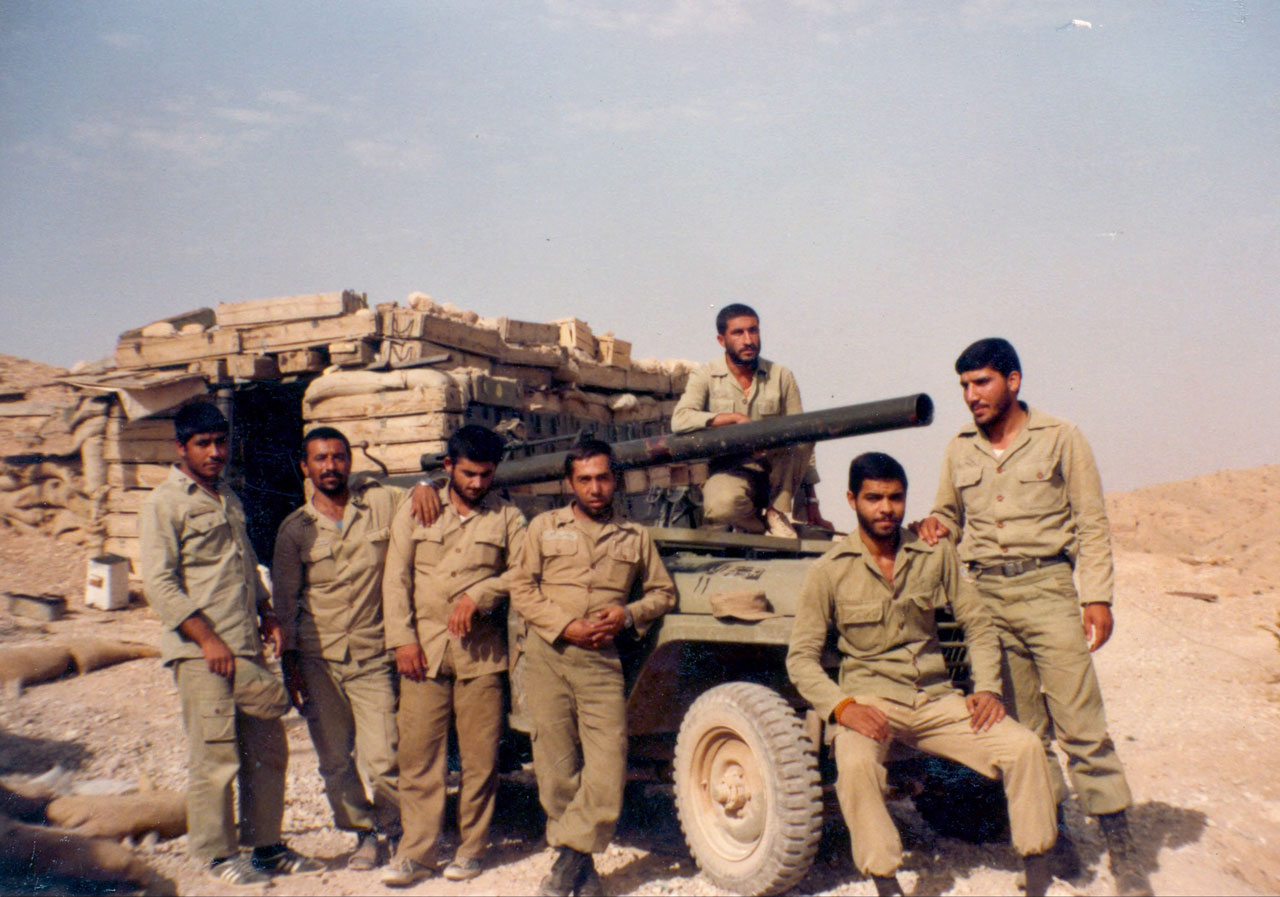 As a kid, I thought that war meant the war between Iran and Iraq. Later I thought that the war was over. But gradually I understood that we were living in an everlasting war, the war which takes away our loved ones in many ways: sometimes with bombs and missile rockets, sometimes with unwanted migrations and over-night escapes and sometimes with the need of survival. When I finally came to know who I am, I realized we try any possible way to survive and have a better life. Right now that I am a mother who is dealing with anxiety about war and terrorism, I don`t know whether I should stay or leave the country!
As a kid, I thought that war meant the war between Iran and Iraq. Later I thought that the war was over. But gradually I understood that we were living in an everlasting war, the war which takes away our loved ones in many ways: sometimes with bombs and missile rockets, sometimes with unwanted migrations and over-night escapes and sometimes with the need of survival. When I finally came to know who I am, I realized we try any possible way to survive and have a better life. Right now that I am a mother who is dealing with anxiety about war and terrorism, I don`t know whether I should stay or leave the country!
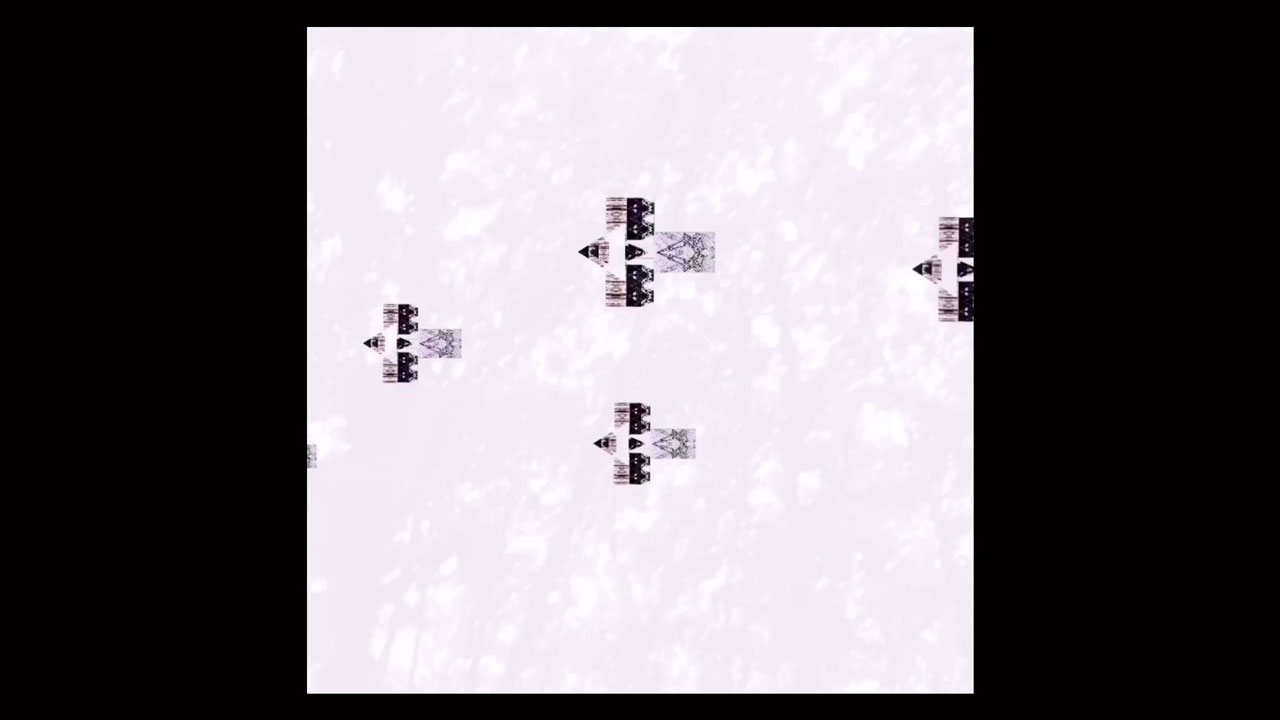 Nature has always been a model for humans to bring the best mechanisms and the best engineering out of their hearts and to artificially use their machines and handcrafts. It is always in the nature of superiority and there is no sustainable pattern that cannot be learned from it, from the model of animal movement to the body structure of animals and plants. Anything in a particular situation can be a good solution to the problems of the human community; just take a deep look at nature! Why humans destroying nature to achieve their goals?! I think, we have been fighting for many years since the relationship between man and nature from a balanced and equal relation to an unequal relationship has transformed and human took control of nature
Nature has always been a model for humans to bring the best mechanisms and the best engineering out of their hearts and to artificially use their machines and handcrafts. It is always in the nature of superiority and there is no sustainable pattern that cannot be learned from it, from the model of animal movement to the body structure of animals and plants. Anything in a particular situation can be a good solution to the problems of the human community; just take a deep look at nature! Why humans destroying nature to achieve their goals?! I think, we have been fighting for many years since the relationship between man and nature from a balanced and equal relation to an unequal relationship has transformed and human took control of nature
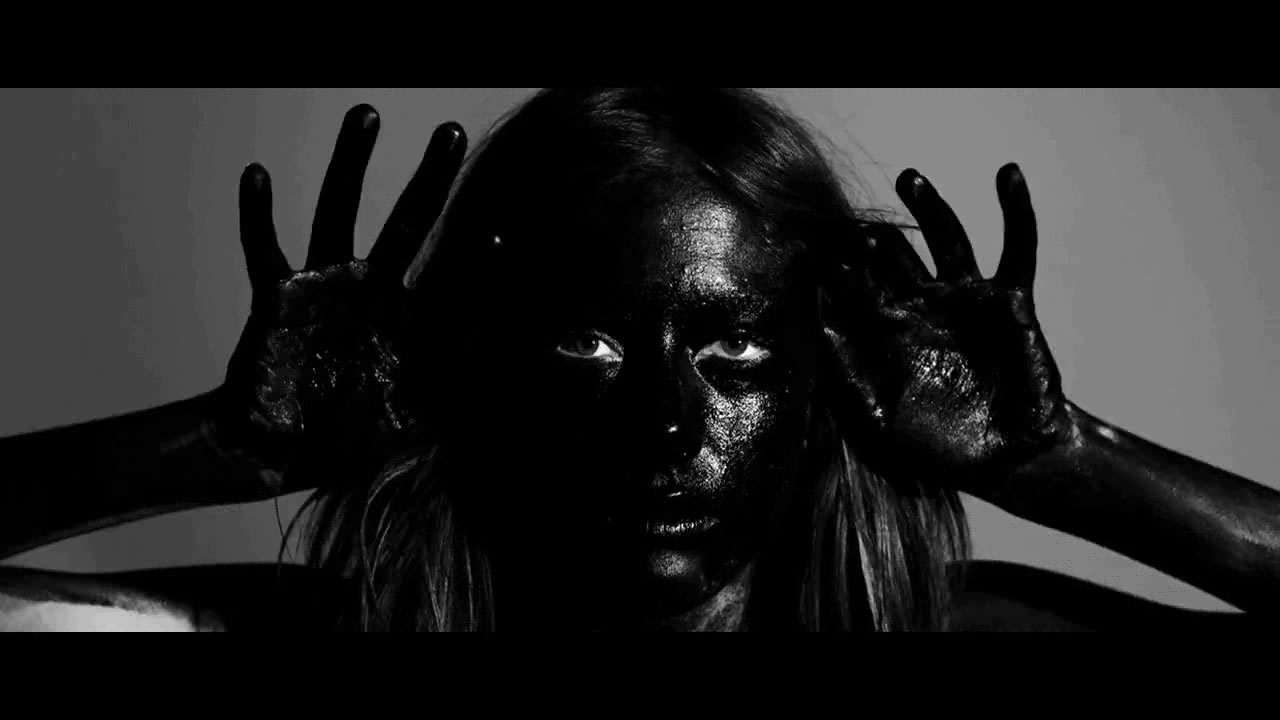 WHAT WILL SAVE US?
WHAT WILL SAVE US?
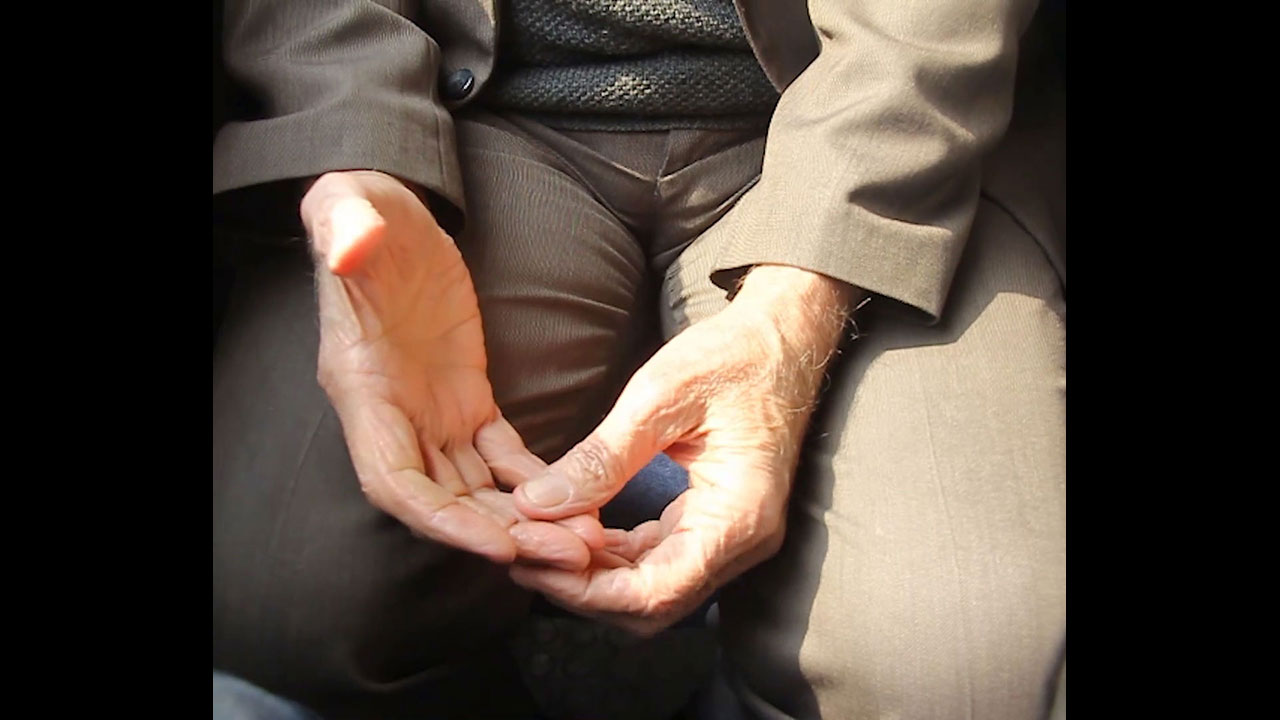 No description
No description
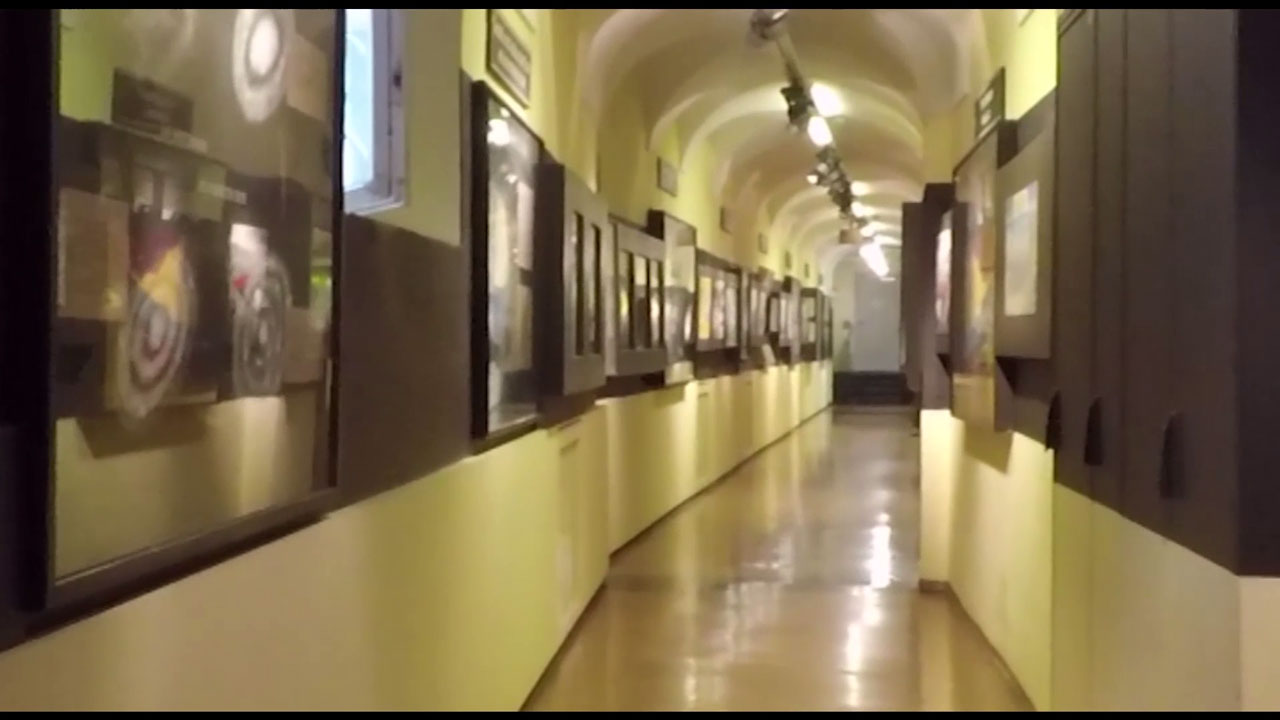 The idea of this video is based on an ecological look at salt mines which are the main reason Salzburg city was built. These salt mines were chosen as a site and have become a tourist attraction in recent years. Subordination of nature seems to prevail in a new set.
The idea of this video is based on an ecological look at salt mines which are the main reason Salzburg city was built. These salt mines were chosen as a site and have become a tourist attraction in recent years. Subordination of nature seems to prevail in a new set.
This film tries to imitate a video essay regarding this subject. It begins with recording of an audio tour about the history of the salt mine. A sudden change of direction happens in the narration after the interlude goes through an inner journey. Subordination of nature and an inner journey become parallel together, representing exploitation in different levels with a non-anthropocentric approach.
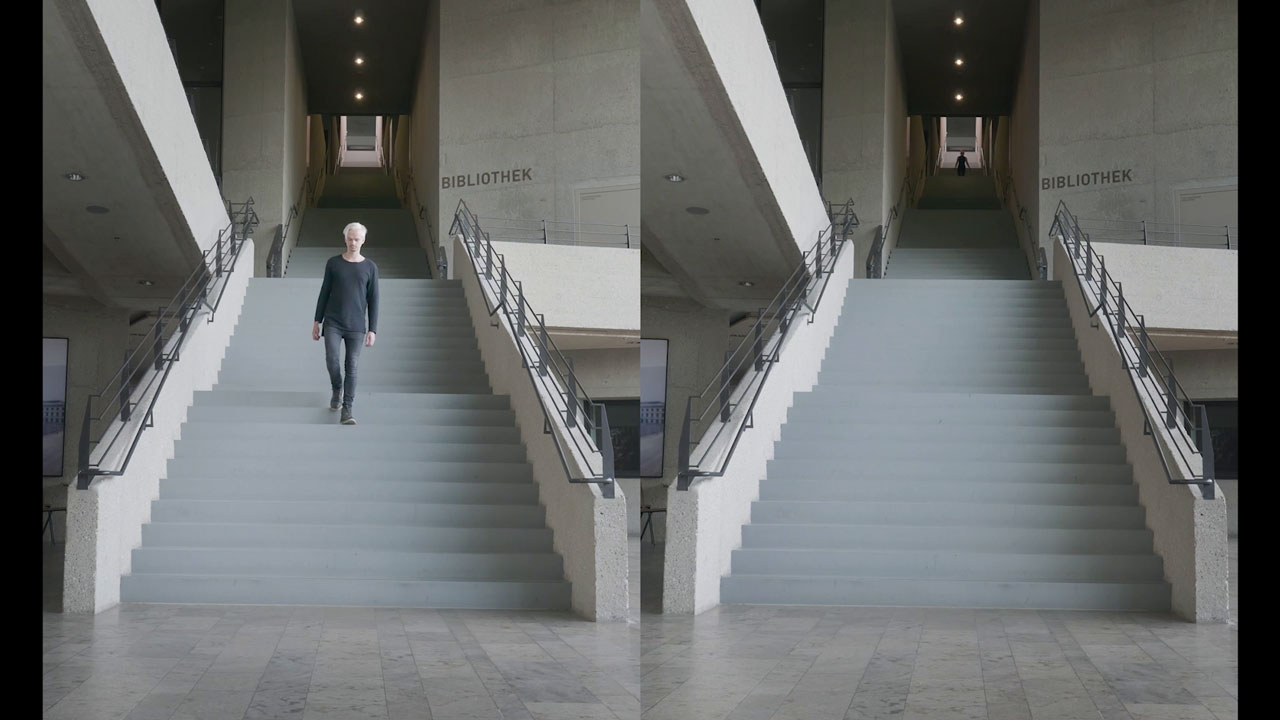 “Stairway” is a two-channel video, showing the artist duo Anne Pfeifer and Bernhard Kreutzer walking up and down a long flight of stairs. If Kreutzer is going down the stairs, Pfeifer is going up, and vice versa. It only appears however that the artists are climbing and descending the stairs in a conventional way. The film footage is being played backward and in reality, the duo runbacks up and down the stairs.
“Stairway” is a two-channel video, showing the artist duo Anne Pfeifer and Bernhard Kreutzer walking up and down a long flight of stairs. If Kreutzer is going down the stairs, Pfeifer is going up, and vice versa. It only appears however that the artists are climbing and descending the stairs in a conventional way. The film footage is being played backward and in reality, the duo runbacks up and down the stairs.
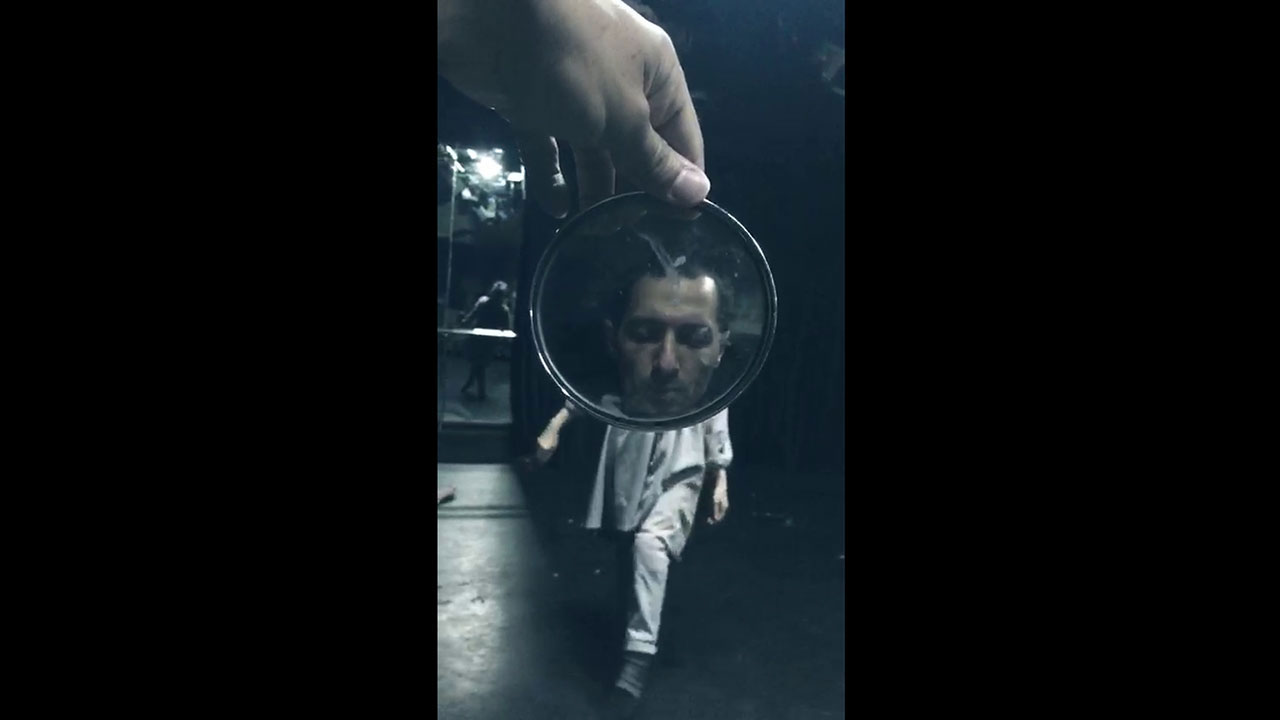 It may have been a hundred years of cloudy weather. Our situation is all too sad, but we still feel the heat, and the soul within our body still says there is excitement, even though death is lurking. It’s better not to enjoy the moment, but to create the moment.
It may have been a hundred years of cloudy weather. Our situation is all too sad, but we still feel the heat, and the soul within our body still says there is excitement, even though death is lurking. It’s better not to enjoy the moment, but to create the moment.
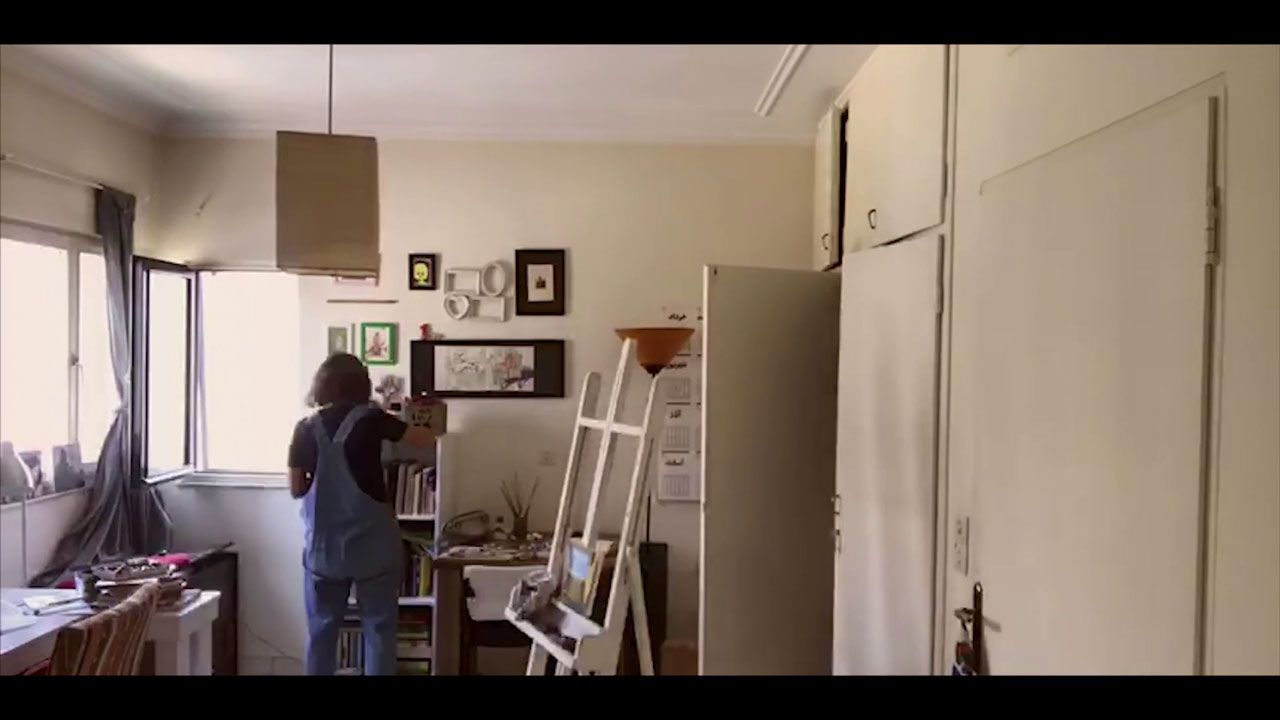 About change and space
About change and space
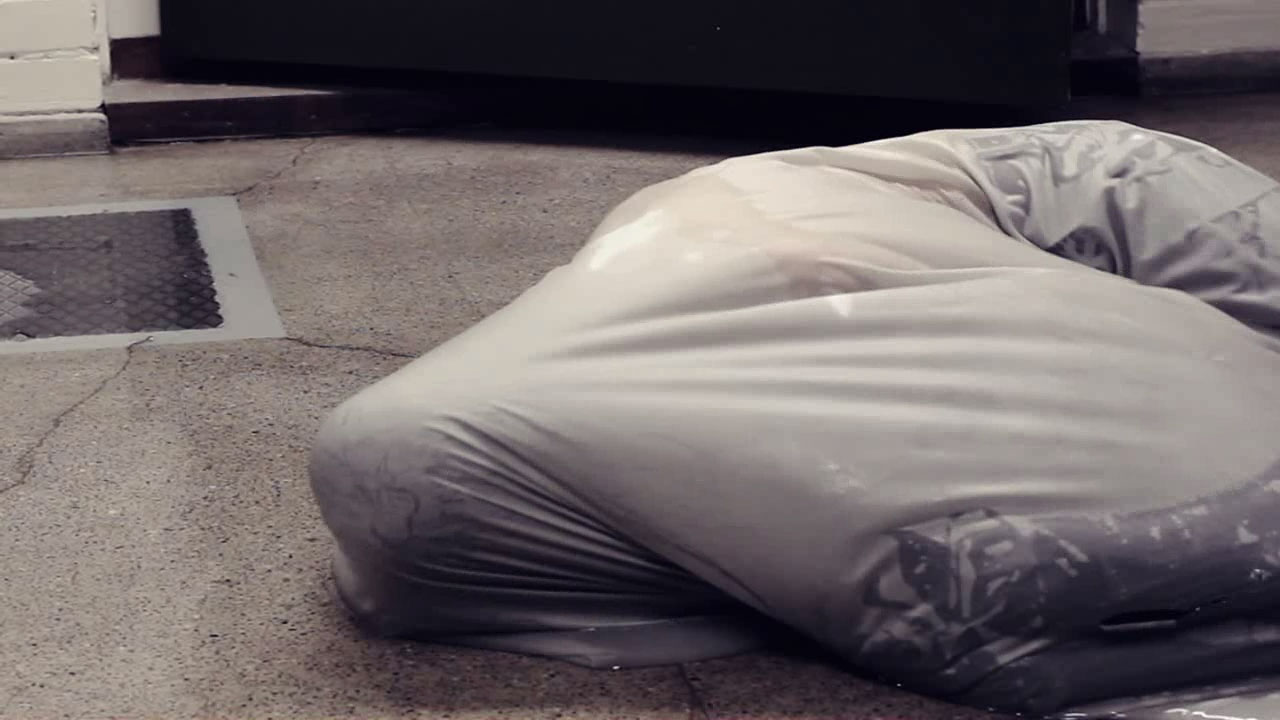 “Parsa Kamehkhosh (b.1985) is a human being based in Helsinki, Finland. Being in the world is all he is trying to experience. Being present with all of his senses and letting himself be touched and fascinated by what life puts forward. He is constantly internalizing his perceptions and reflects on them in the form of “bringing things”. This natural process is actually a way towards understanding his position in the world and expressing his appreciation of it. The outcome usually works either like a mirror that reflects untreated or unrevealed aspects of his personality or practice through which he encounters and contends with his inner tensions. He believes more in bringing than creating because he identifies himself only as a door through which idea can enter the conceivable realm of existence in a certain way. This piece is from the Thing (-ing) collection. As the title, Thing (-ing), is almost a self-made combo which refers to the interaction between the human and things. In this video, Parsa is thing(-ing).”
“Parsa Kamehkhosh (b.1985) is a human being based in Helsinki, Finland. Being in the world is all he is trying to experience. Being present with all of his senses and letting himself be touched and fascinated by what life puts forward. He is constantly internalizing his perceptions and reflects on them in the form of “bringing things”. This natural process is actually a way towards understanding his position in the world and expressing his appreciation of it. The outcome usually works either like a mirror that reflects untreated or unrevealed aspects of his personality or practice through which he encounters and contends with his inner tensions. He believes more in bringing than creating because he identifies himself only as a door through which idea can enter the conceivable realm of existence in a certain way. This piece is from the Thing (-ing) collection. As the title, Thing (-ing), is almost a self-made combo which refers to the interaction between the human and things. In this video, Parsa is thing(-ing).”
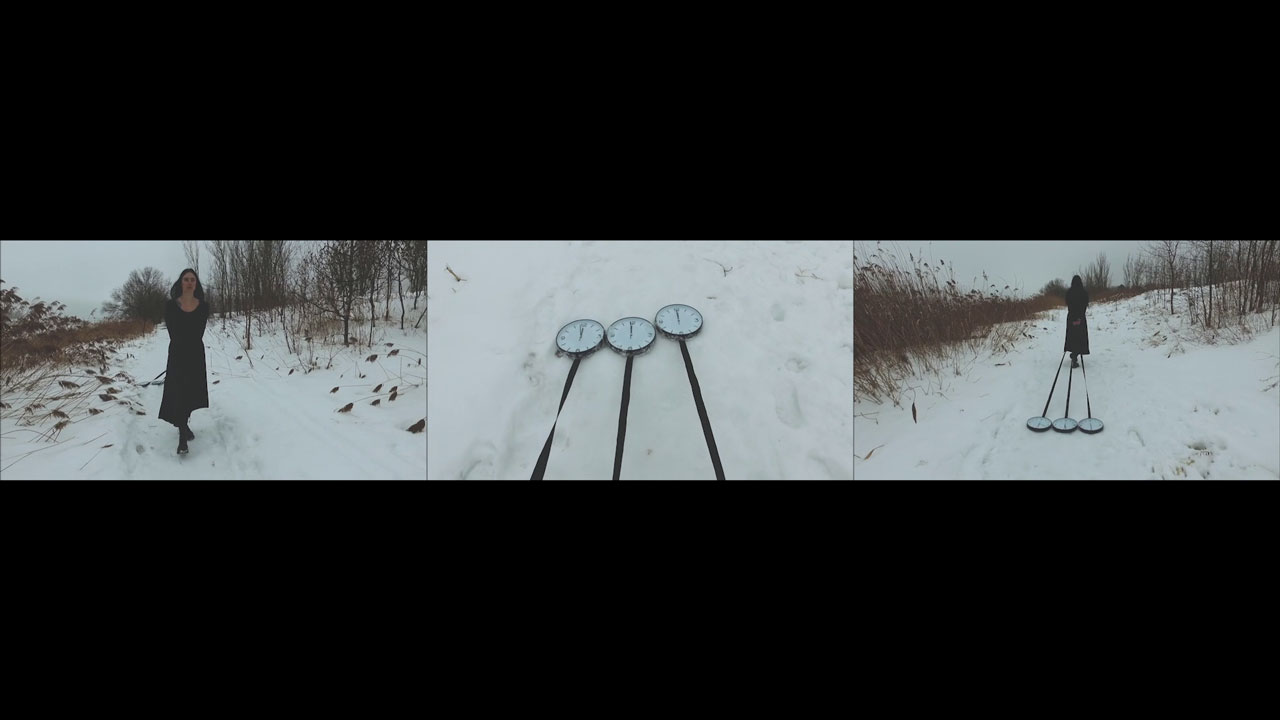 “J’attends le temps / I wait for the time is a video that deals with the notions of inertia and the stoppage of time as experienced by an anonymous protagonist. In the video, time in its various states is represented by three clocks affixed to a black-clad figure. Fixed in the present moment, the performer moves through an inert and repulsive frozen landscape. This video explores the relative nature of time’s passage and troubles its conception as uniform and straightforward. The image of a place appears frozen in one’s memory whereas time’s forward motion continues outside the viewer’s personal sphere. P.S: “I wait for the time” has been produced as part of a residency at Studio XX, ORORO and GIV in 2018 and is supported by the Conseil des arts de Montréal’s DémART-Mtl program.”
“J’attends le temps / I wait for the time is a video that deals with the notions of inertia and the stoppage of time as experienced by an anonymous protagonist. In the video, time in its various states is represented by three clocks affixed to a black-clad figure. Fixed in the present moment, the performer moves through an inert and repulsive frozen landscape. This video explores the relative nature of time’s passage and troubles its conception as uniform and straightforward. The image of a place appears frozen in one’s memory whereas time’s forward motion continues outside the viewer’s personal sphere. P.S: “I wait for the time” has been produced as part of a residency at Studio XX, ORORO and GIV in 2018 and is supported by the Conseil des arts de Montréal’s DémART-Mtl program.”
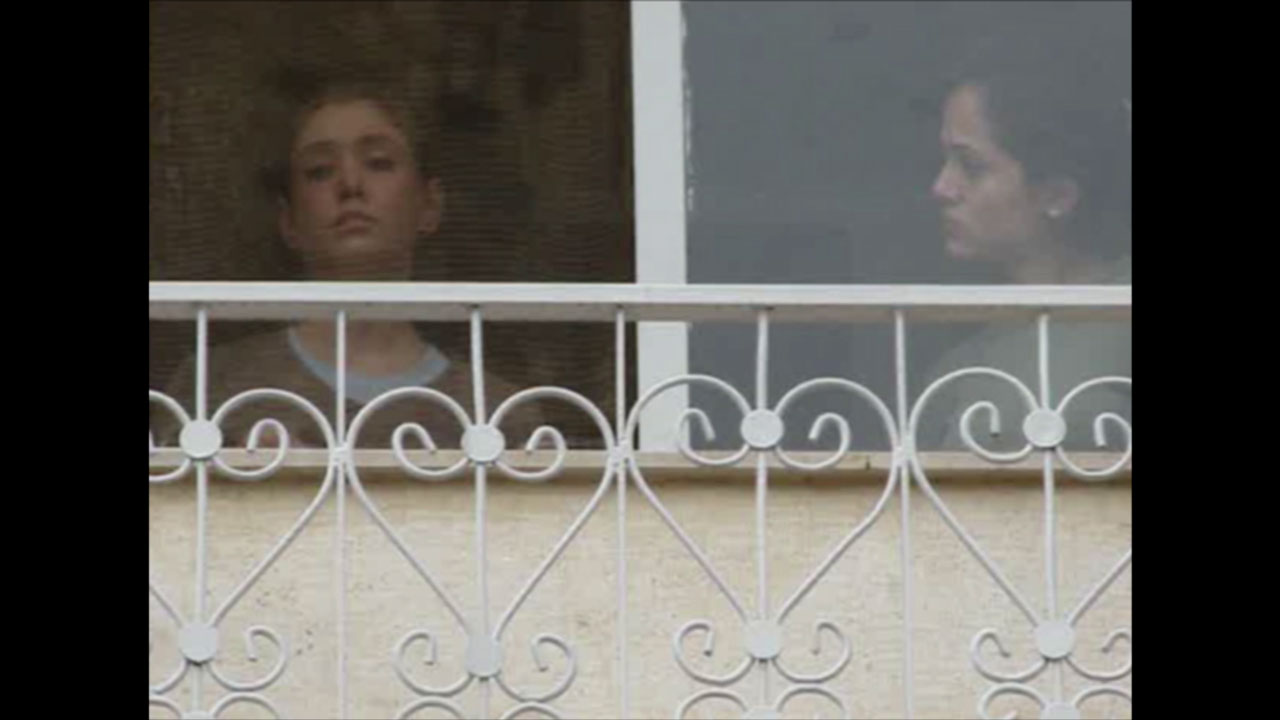 This is a close-up image of a window while shooting the connection or disconnection between two women. Of course, you as the spectator make the third head of this triangle.
This is a close-up image of a window while shooting the connection or disconnection between two women. Of course, you as the spectator make the third head of this triangle.
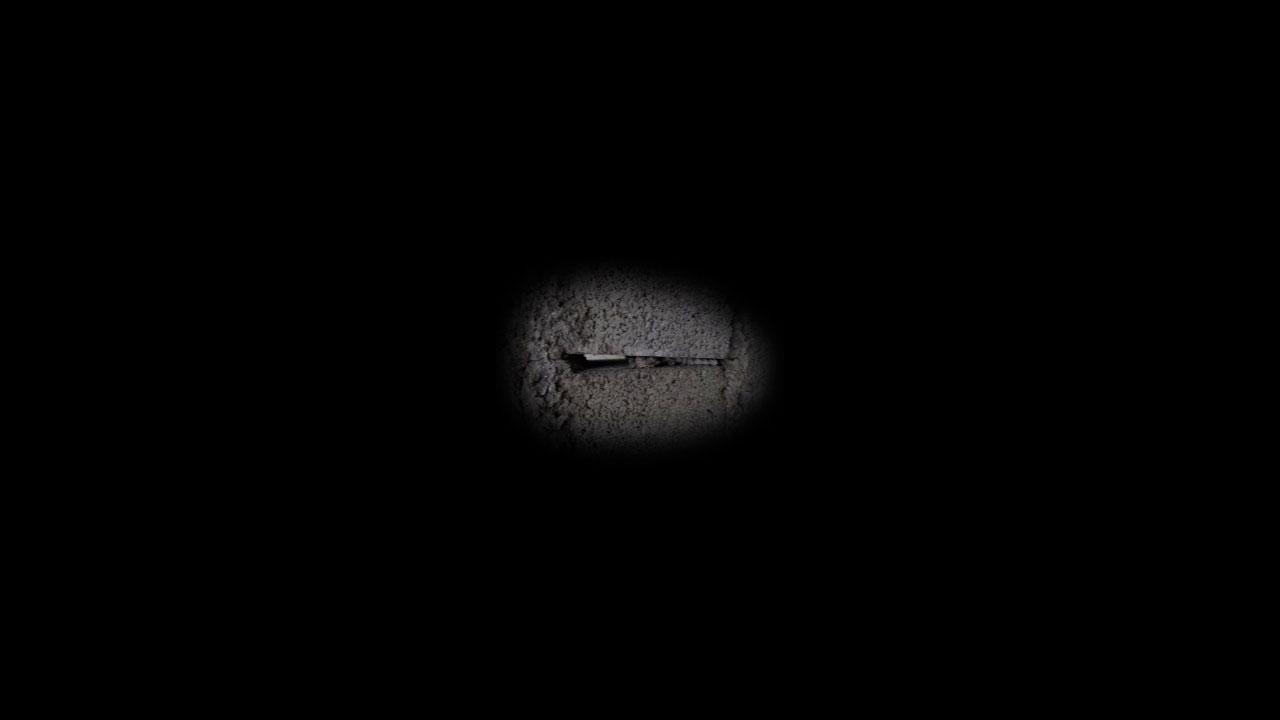 The headline or heading is the text indicating the nature of the article below it. The headline’s purpose is to quickly and briefly draw attention to the story.
The headline or heading is the text indicating the nature of the article below it. The headline’s purpose is to quickly and briefly draw attention to the story.
